habu Shabu is a famous Japanese hot pot where everyone at the table cooks together. Diners swish marbled meat, tofu, and vegetables in a light broth and enjoy it with savory dipping sauce. It’s an intimate yet casual meal that’s fun and easy to pull off at home.
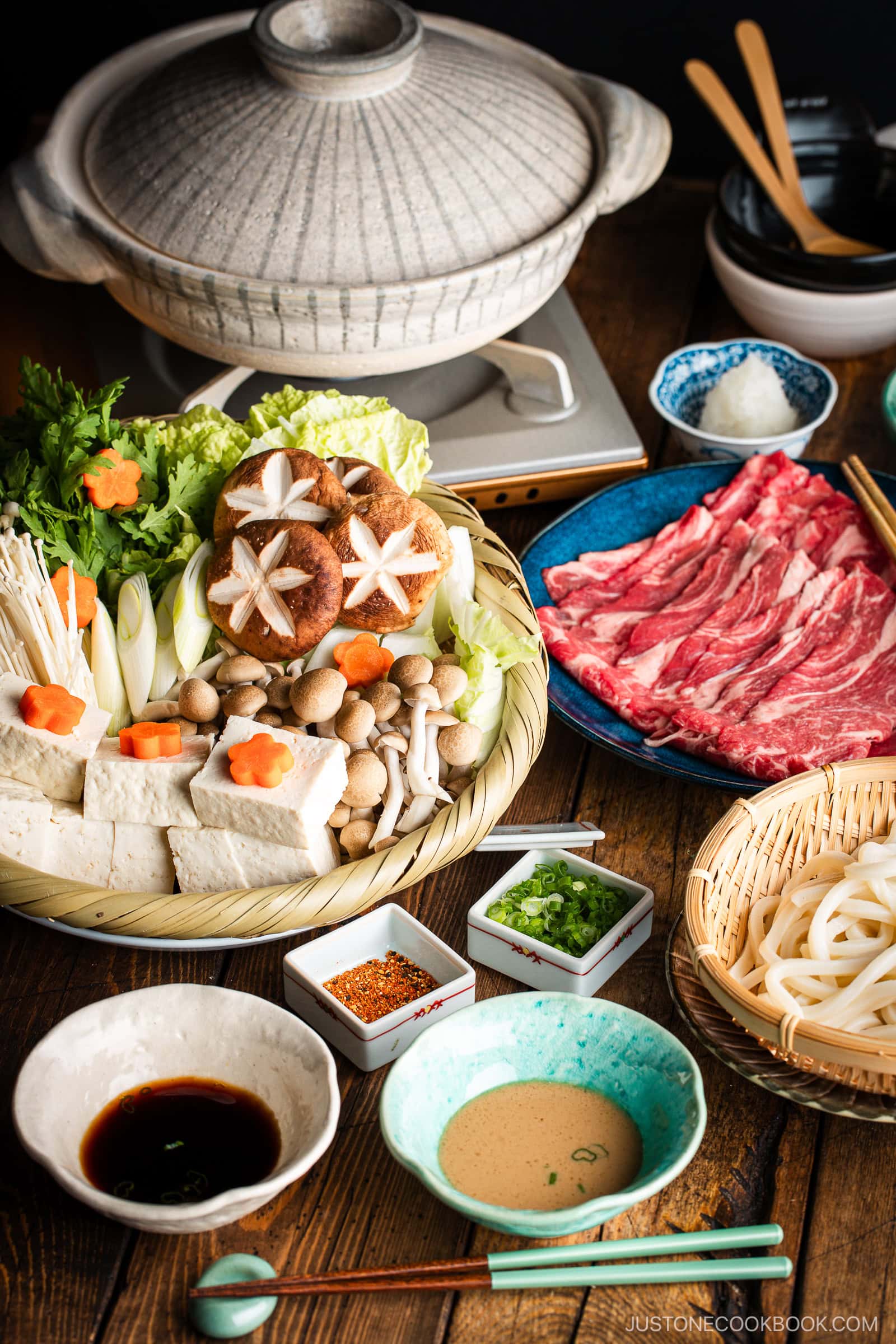
Hot pot is the ultimate cold-weather comfort food. It’s a lively, communal meal that everyone enjoys cooking together at the table. While we have many hot pot recipes in Japan, I suggest starting with Shabu Shabu (しゃぶしゃぶ). I’ll guide you through the easy prep and cooking steps so you can share this dish at home with your family and friends.
If you’re craving more hot pot recipes, try my Yosenabe, Sukiyaki, and Mille-Feuille Nabe next!
Table of Contents
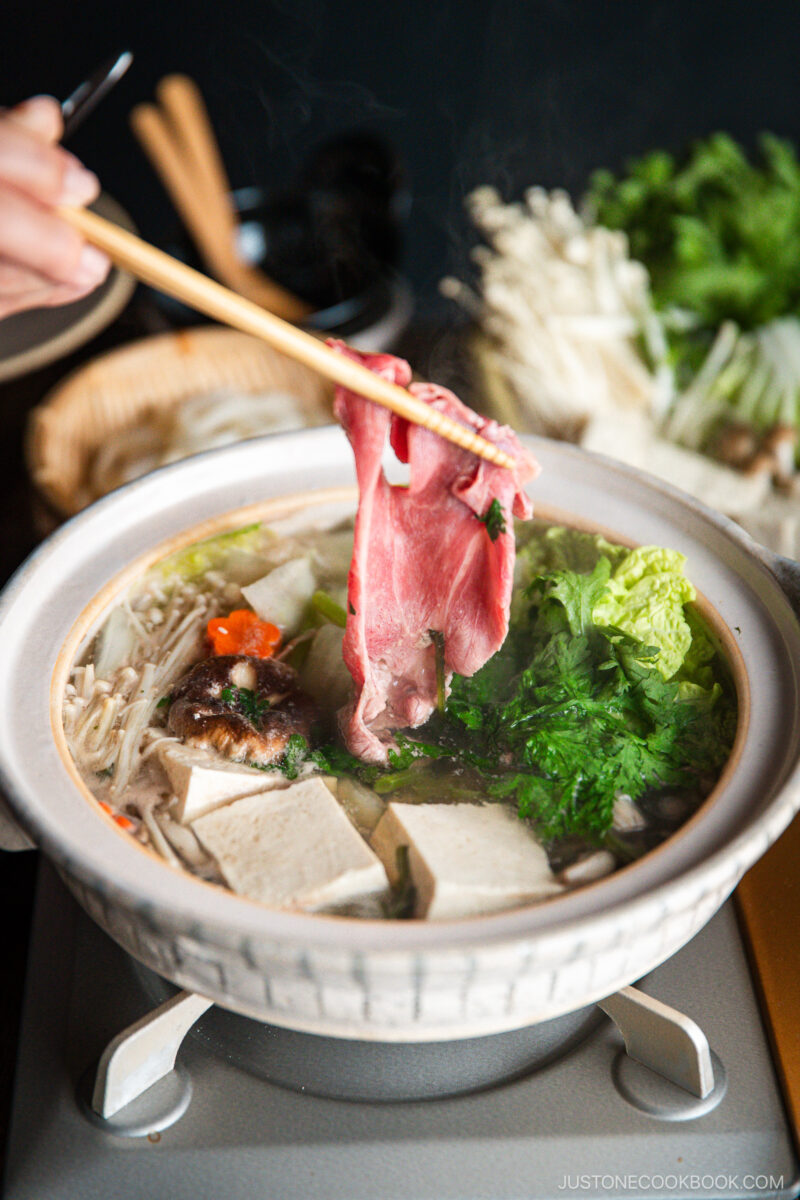
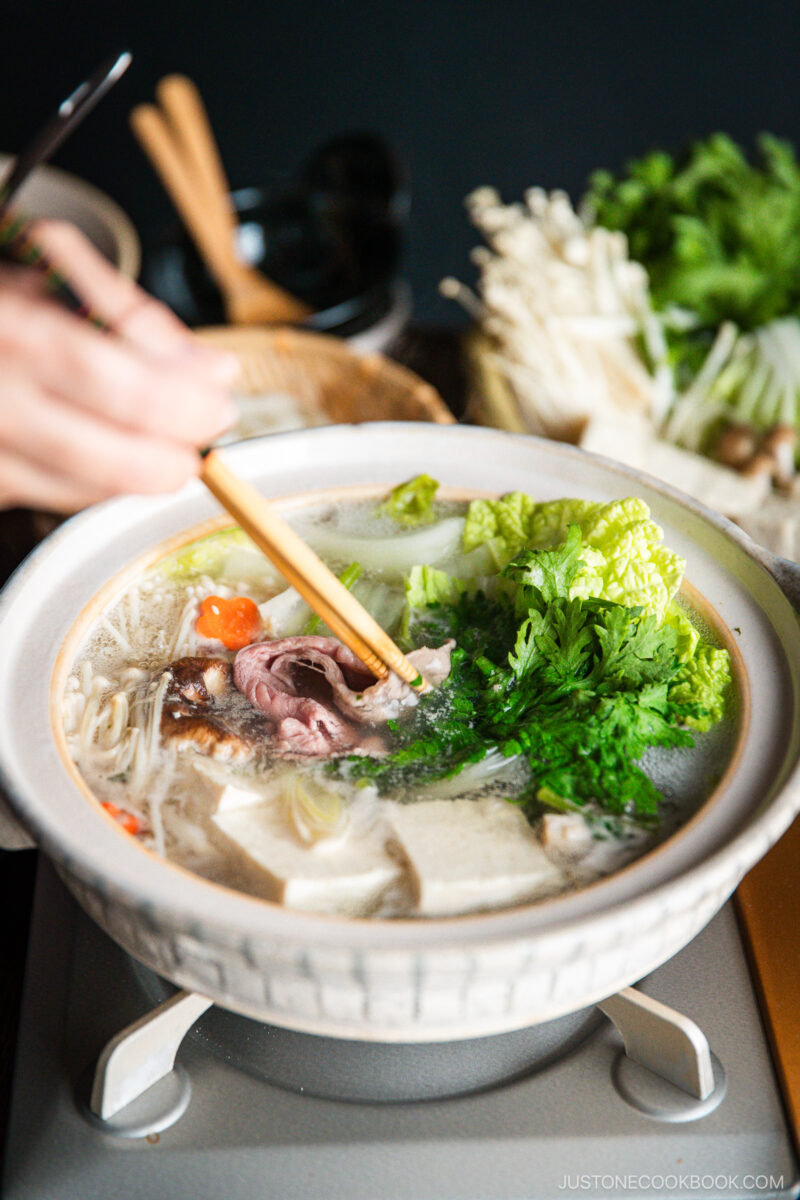
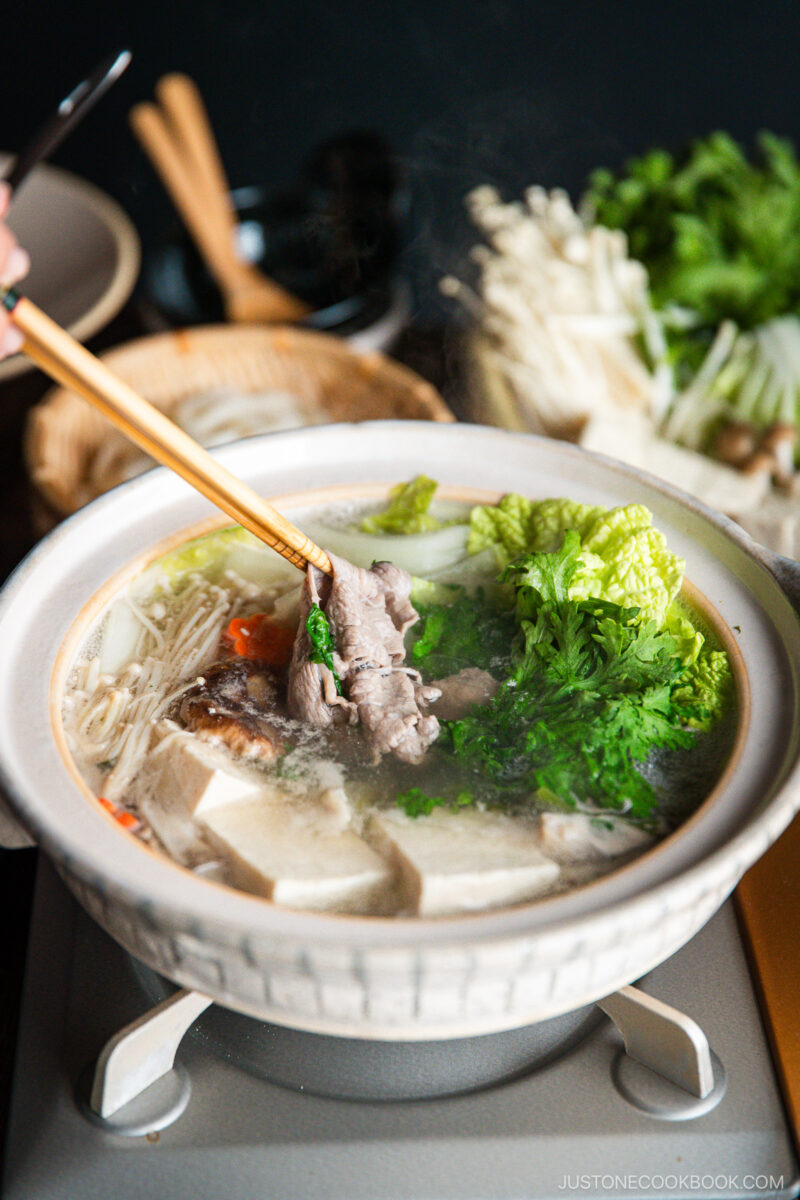
What is Shabu Shabu?
Shabu shabu is Japanese onomatopoeia for the “swish-swish” sound of cooking the meat and vegetables in the light dashi broth. It’s one of Japan’s most popular hot pot dishes where the diners cook the meal together at the table in a communal Japanese clay pot (donabe). While hot pot may have originated in Inner Mongolia and China, this classic Japanese variation was invented in the early 1950s at Suehiro restaurant in Osaka.
Why I Love This Recipe
- No pre-cooking needed: Just cut the ingredients and let everyone cook it at the table. I love not cooking before dinnertime!
- Light and nutritious: Everything cooks in hot broth, not oil. It’s a low-fat cooking method and a great way to add vegetables and tofu to your diet.
- It’s quick and easy: As a busy mom, I make this simple and low-effort meal during the holidays or on a weeknight.
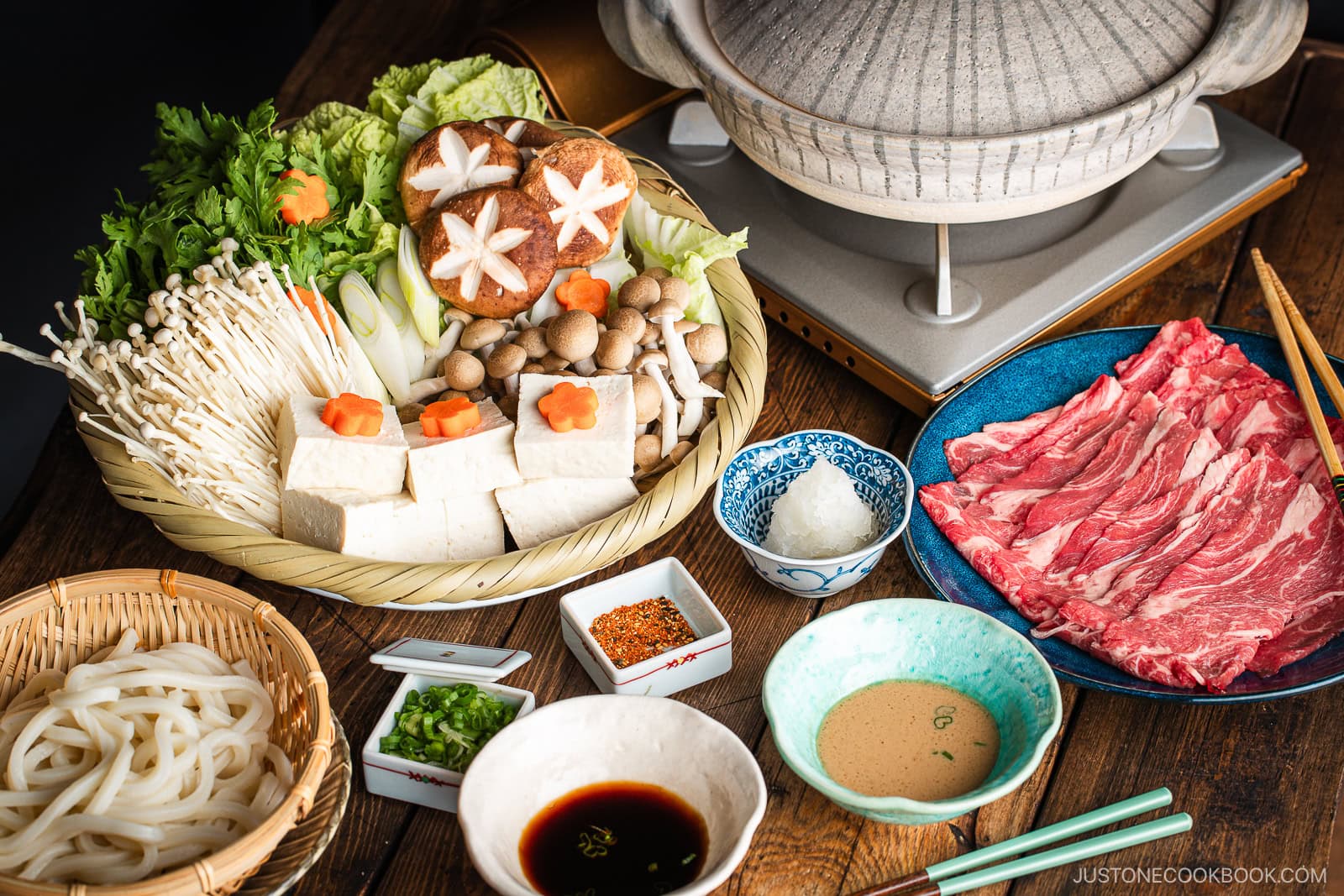
Ingredients for Shabu Shabu
- Kombu (dried kelp) and water
- Thinly sliced beef (chuck or ribeye; well marbled)
- Medium-firm tofu
- Shiitake mushrooms, enoki mushrooms, and shimeji mushrooms
- Napa cabbage
- Shungiku (chrysanthemum greens)
- Tokyo negi (long green onion) – or use the white part of a leek or green onions
- Carrot
- Udon noodles – frozen or parboiled
- Sesame sauce and ponzu sauce – for dipping
- Grated daikon radish, chopped green onions/scallions, and shichimi togarashi (Japanese seven spice) – for the sauce condiments
Find the printable recipe with measurements below.
Jump to RecipeSubstitutions
- Kombu dashi: We always use soup stock made with dried kelp for this dish. Simply drop a piece of kombu in a pot of water and let it steep. That’s it! If you can’t find kombu, you can use another dashi.
- Thinly-sliced beef or pork: Select well-marbled meat labeled “for shabu shabu” from a Japanese or Korean grocery store. If you can’t find it, you can slice good-quality chuck or rib eye yourself using my How to Slice Meat Thinly tutorial.
- Dipping sauces: You can find bottled ponzu (citrus soy sauce) and creamy sesame sauce on Amazon or at an Asian/Japanese supermarket. I like the fresh taste of my Homemade Ponzu Sauce and Homemade Sesame Sauce recipes, so please give them a try!
- Shungiku and Tokyo negi: Try a Japanese or Asian grocery store for harder-to-find produce like shungiku, long green onion, and Japanese mushrooms. Or, you can swap your choice of leafy greens and vegetables.
Key Kitchen Tools or Key Equipment
- portable gas stove and gas canister
- donabe, heavy-bottomed pot, or electric hot pot
- long cooking chopsticks
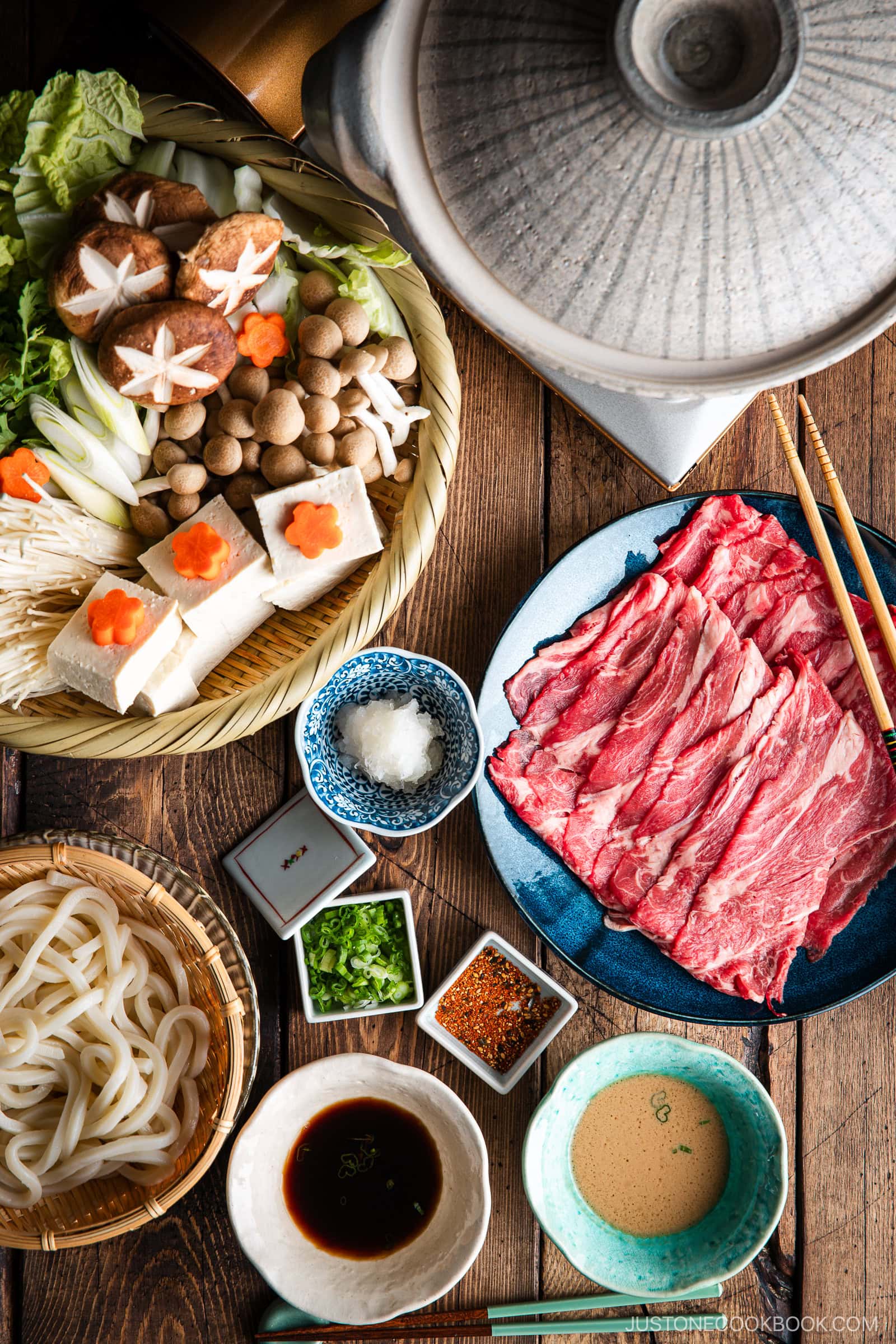
How to Make Shabu Shabu
Preparation
Step 1 – Prepare the broth and reheat the udon. Soak the kombu and water in a donabe for at least 30 minutes. Meanwhile, if you’re going to serve udon noodles at the end of your hot pot meal, reheat the frozen udon in boiling water. Drain and set aside on a plate.
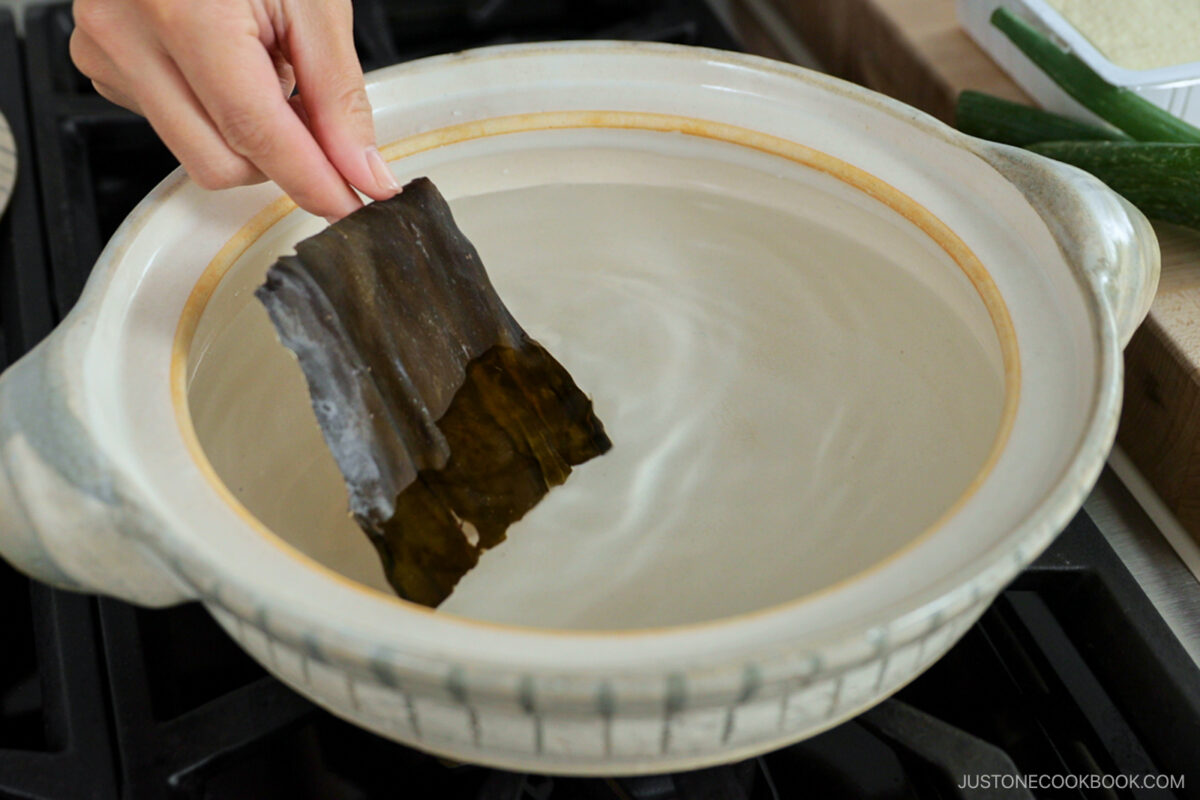
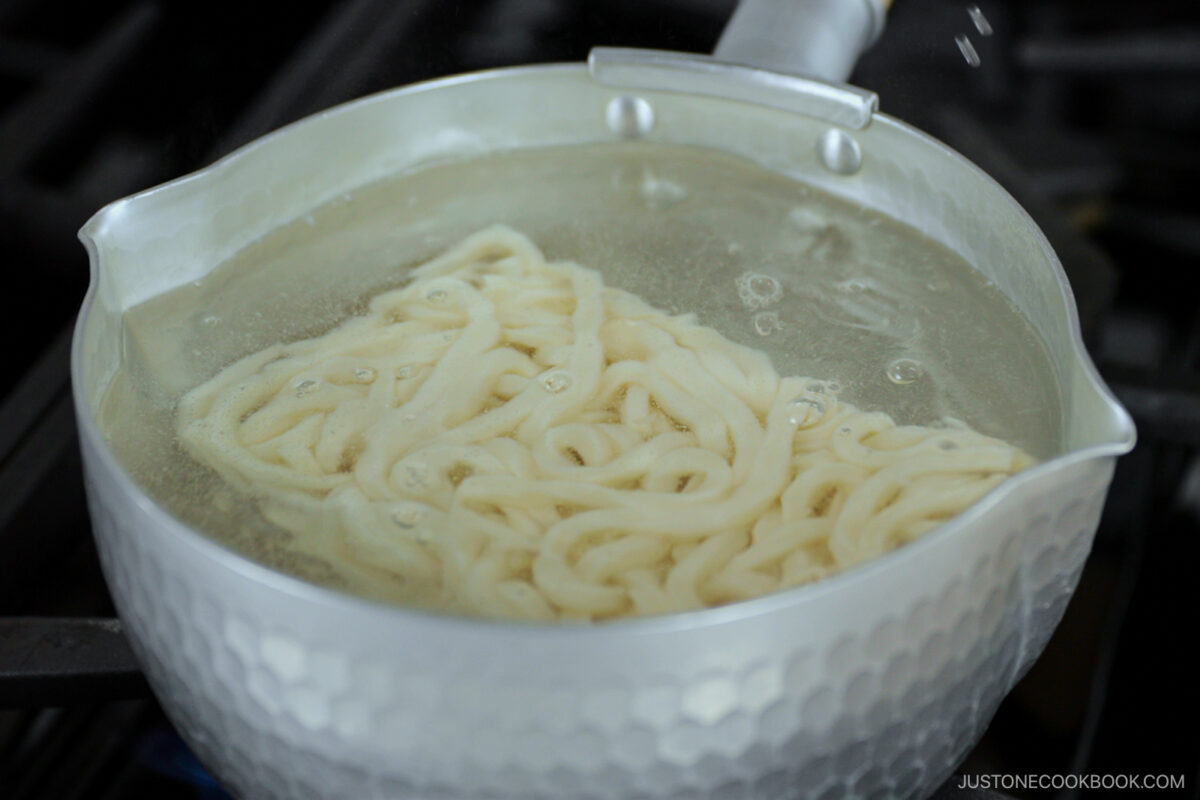
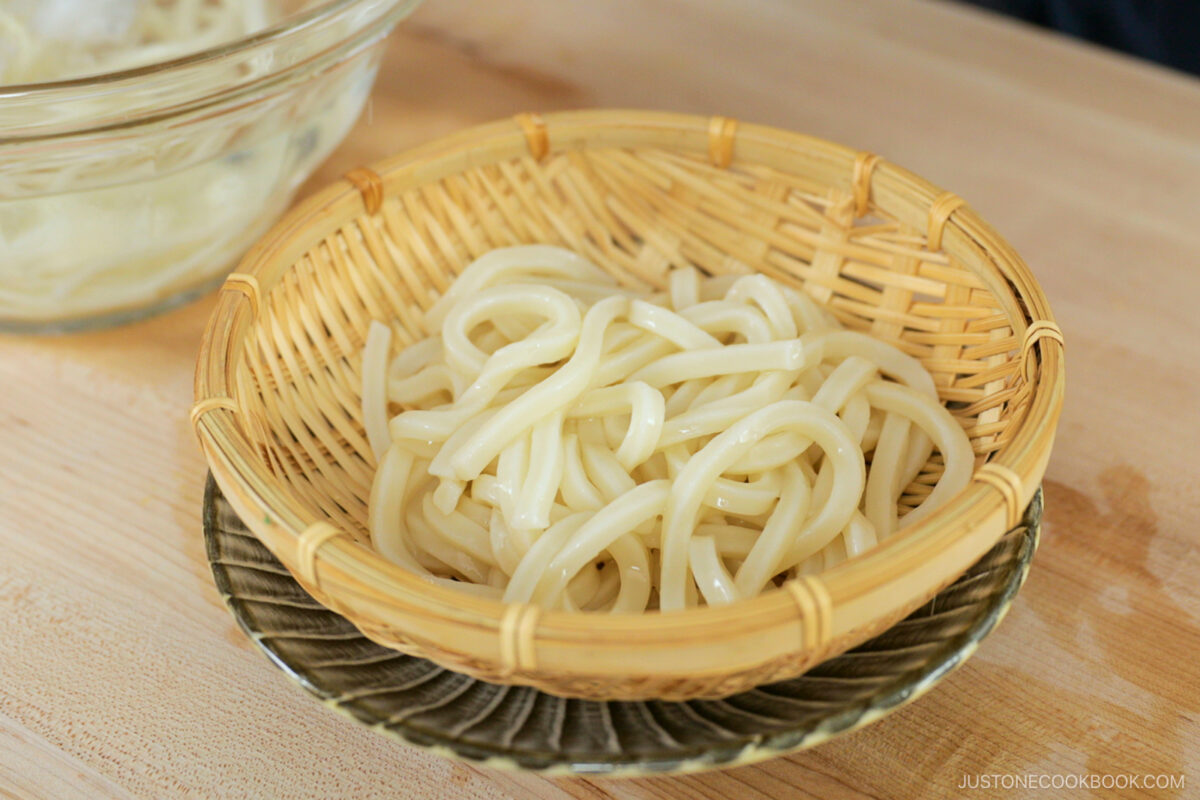
Step 2 – Cut the vegetables. Cut the napa cabbage, shungiku, carrots, and Tokyo negi into bite-sized pieces. Grate the daikon and chop the green onion and place in small bowls.
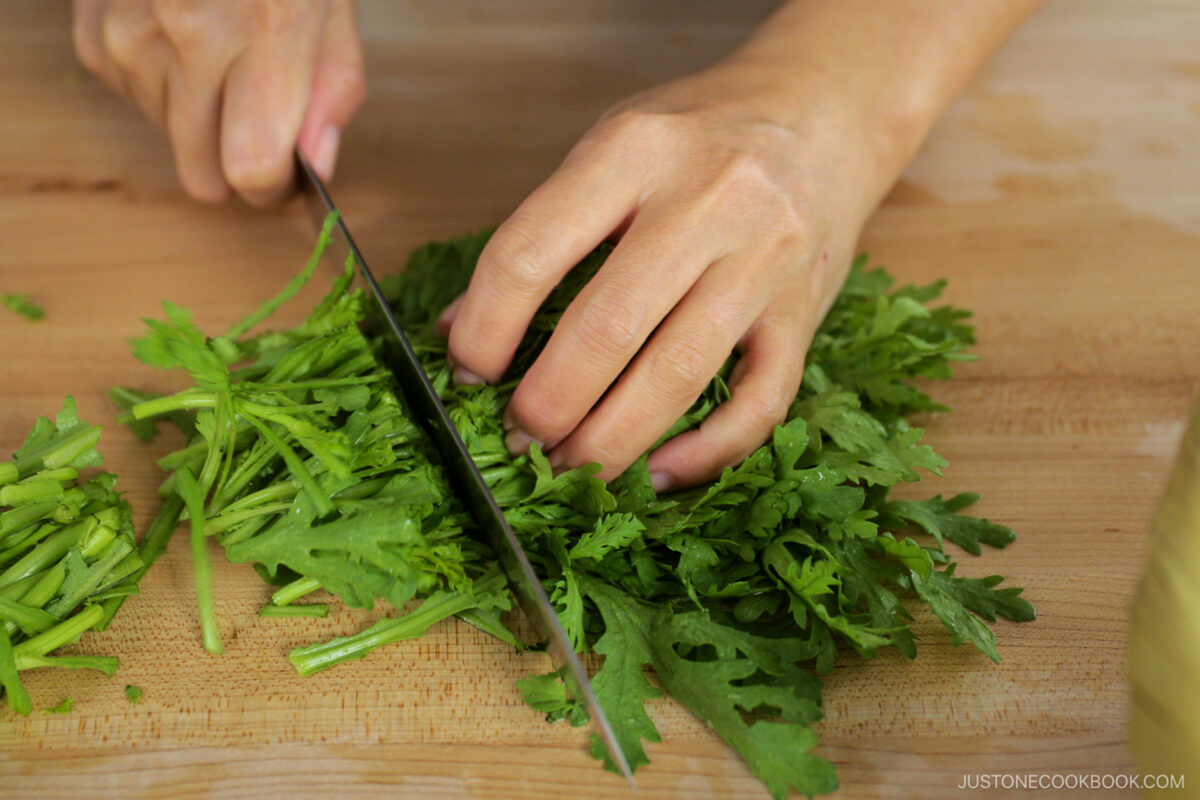
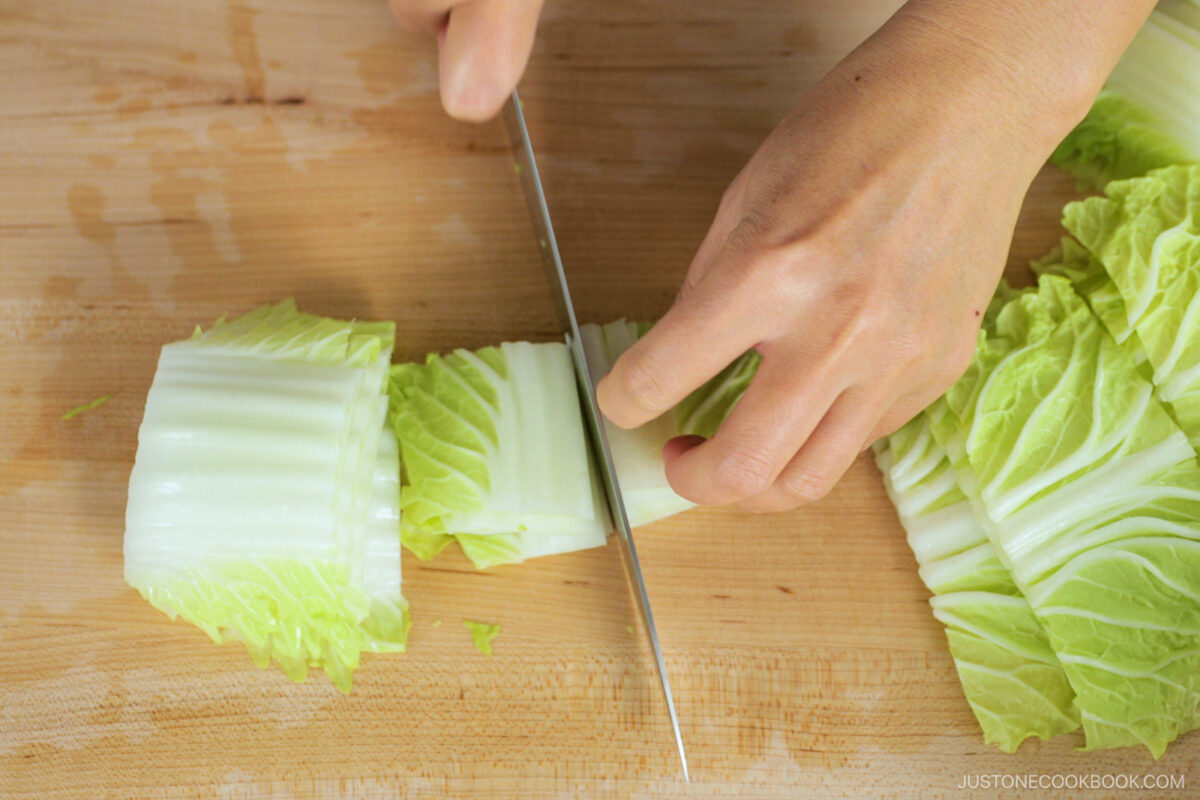
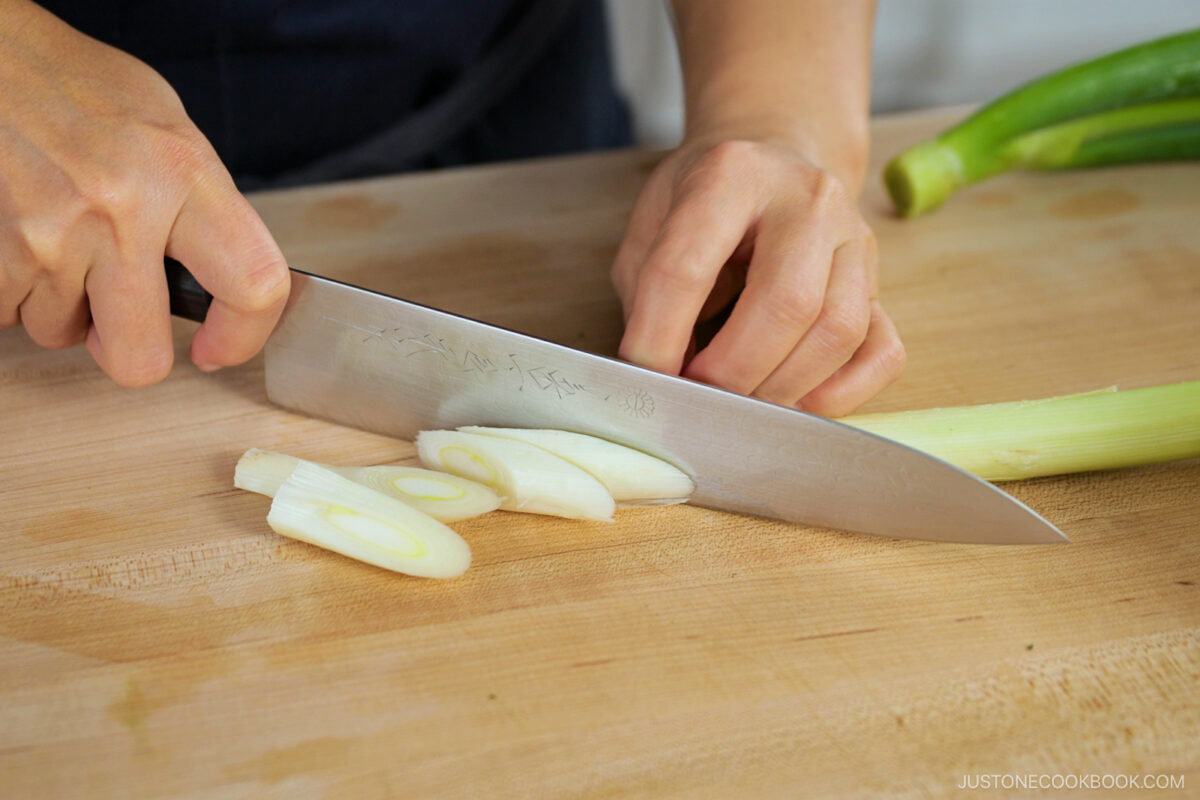
Step 3 – Prep the mushrooms and tofu. Break the shimeji and enoki into smaller chunks and cut the shiitake stems. Cut the tofu.
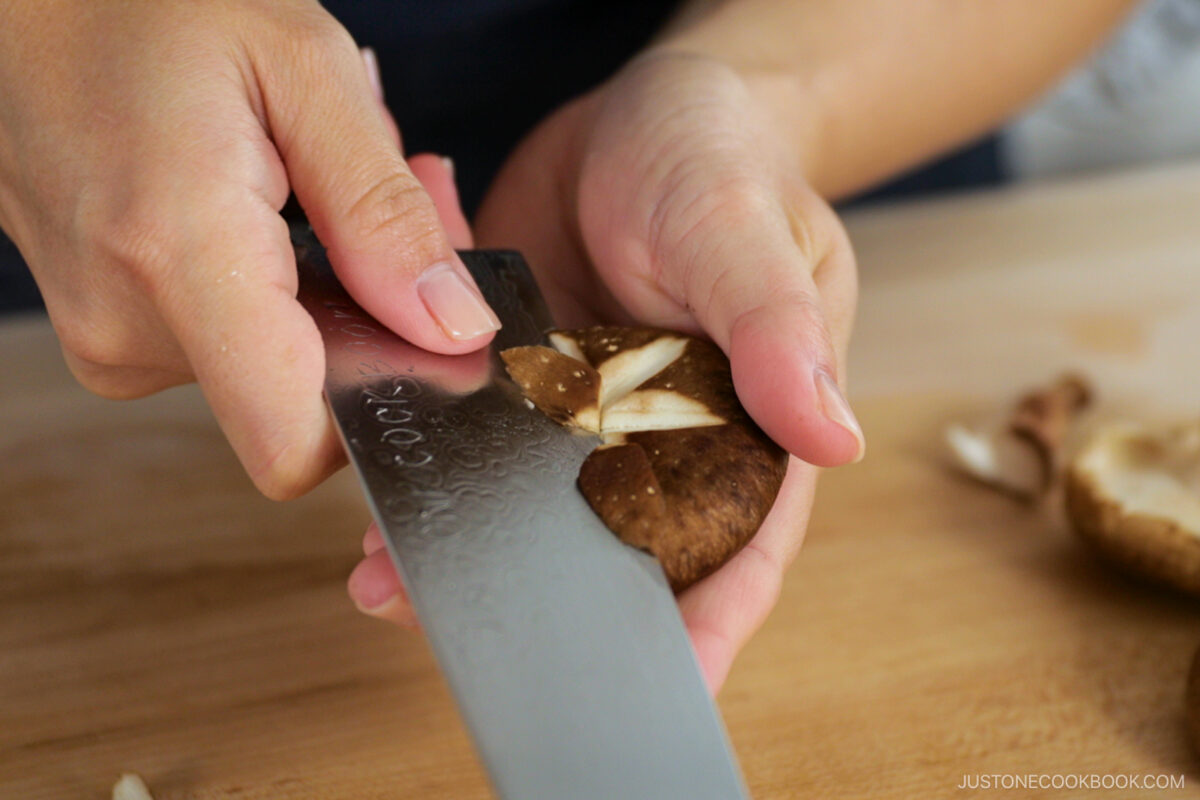
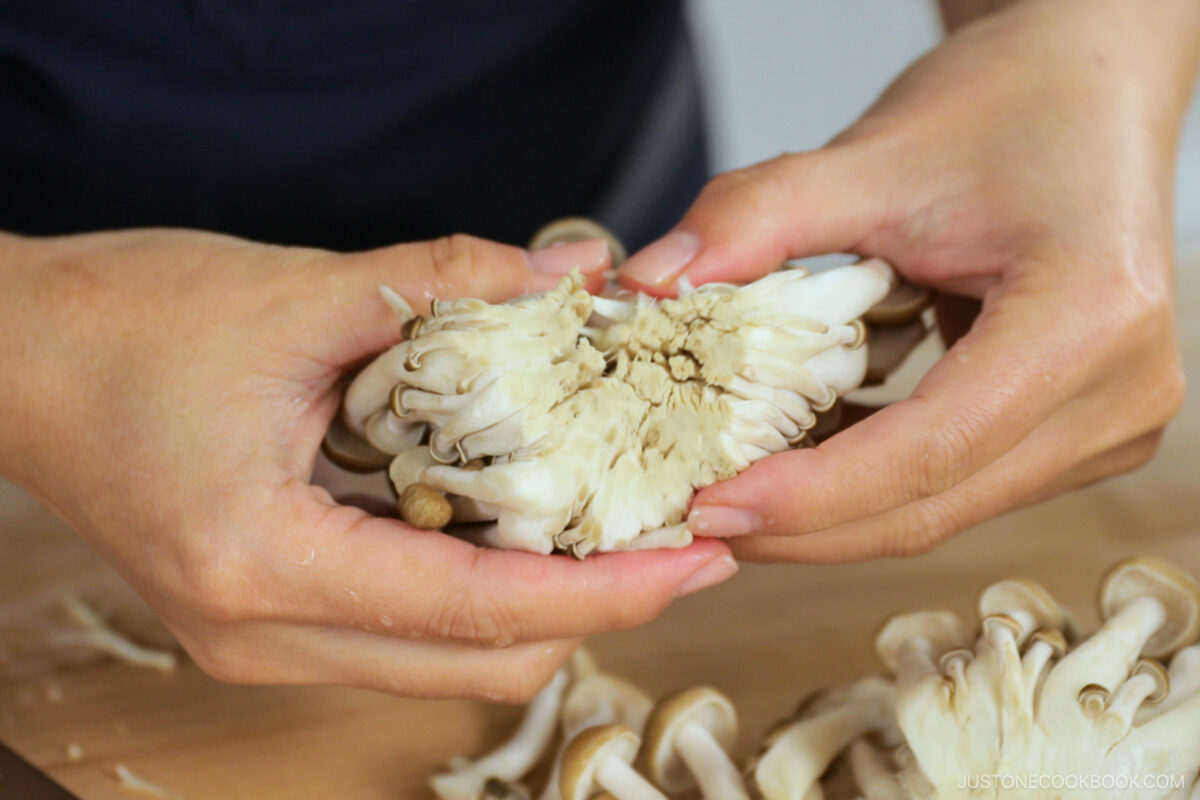
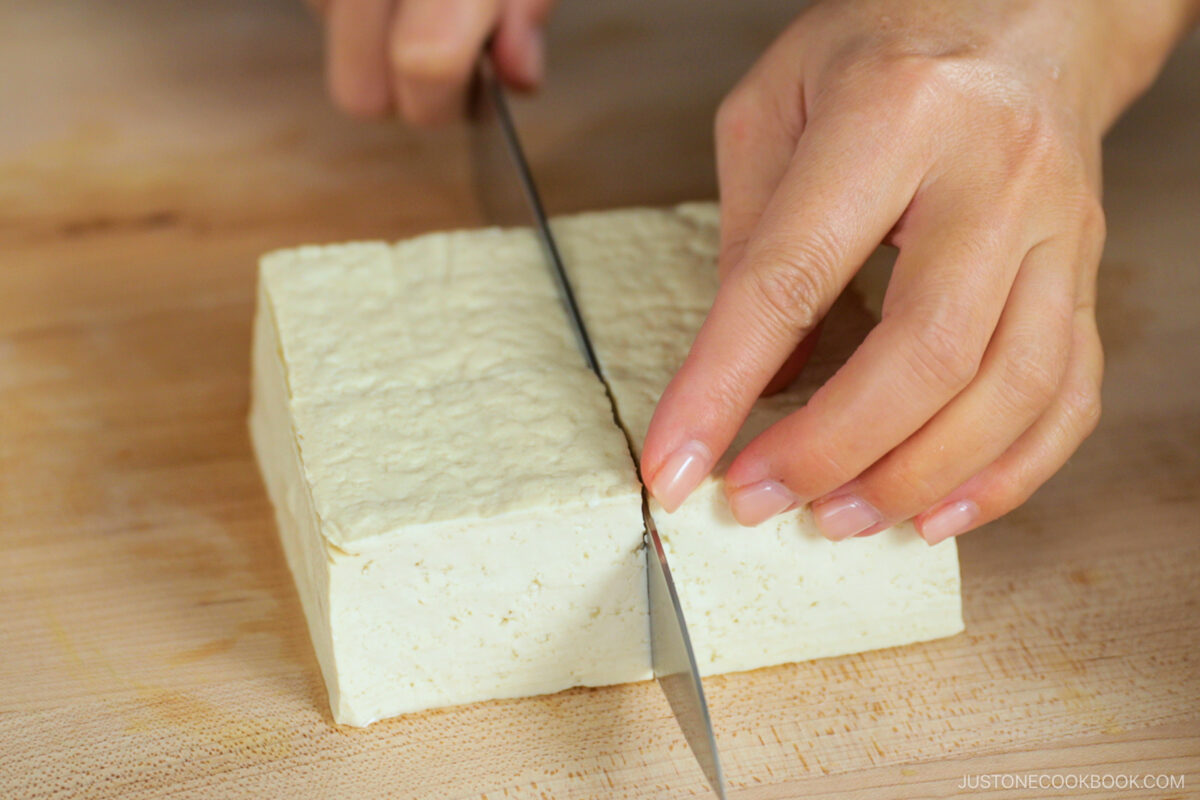
Step 4 – Arrange the platters. Set the tofu, mushrooms and vegetables on one plate and the beef on another. Place them on the table along with the donabe and portable burner.
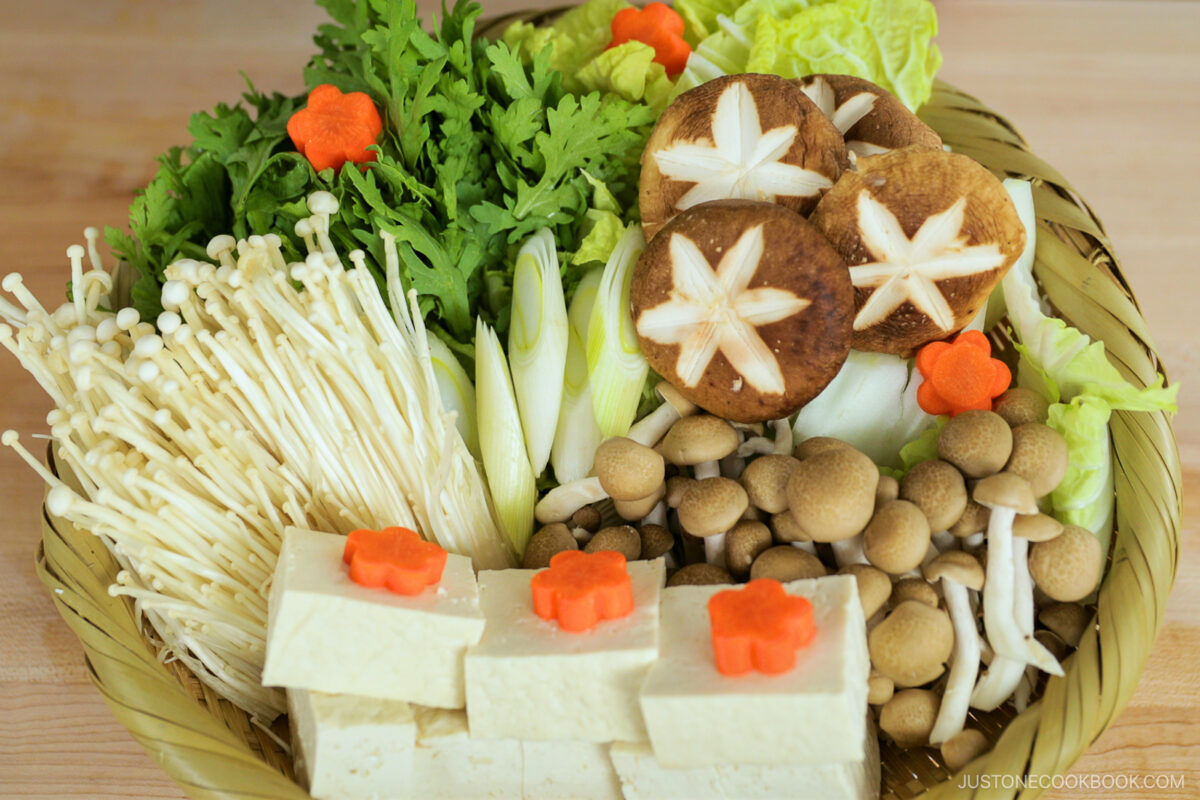
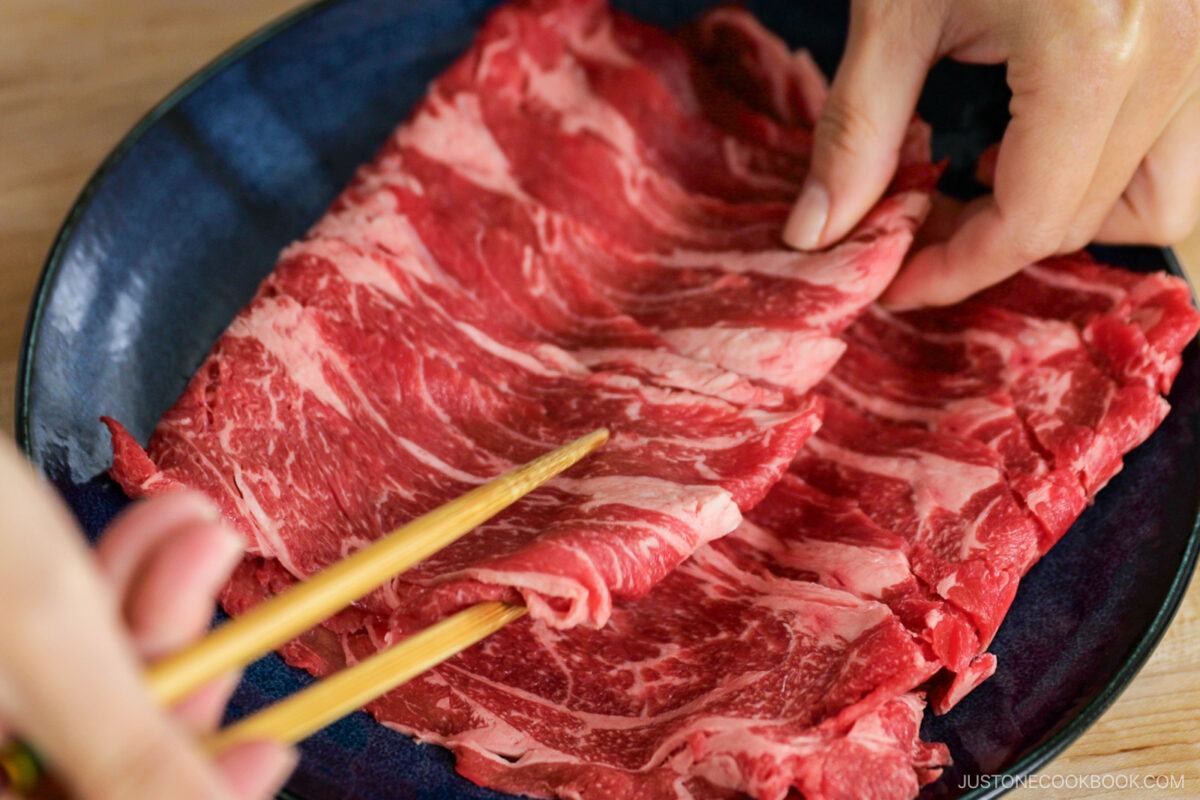
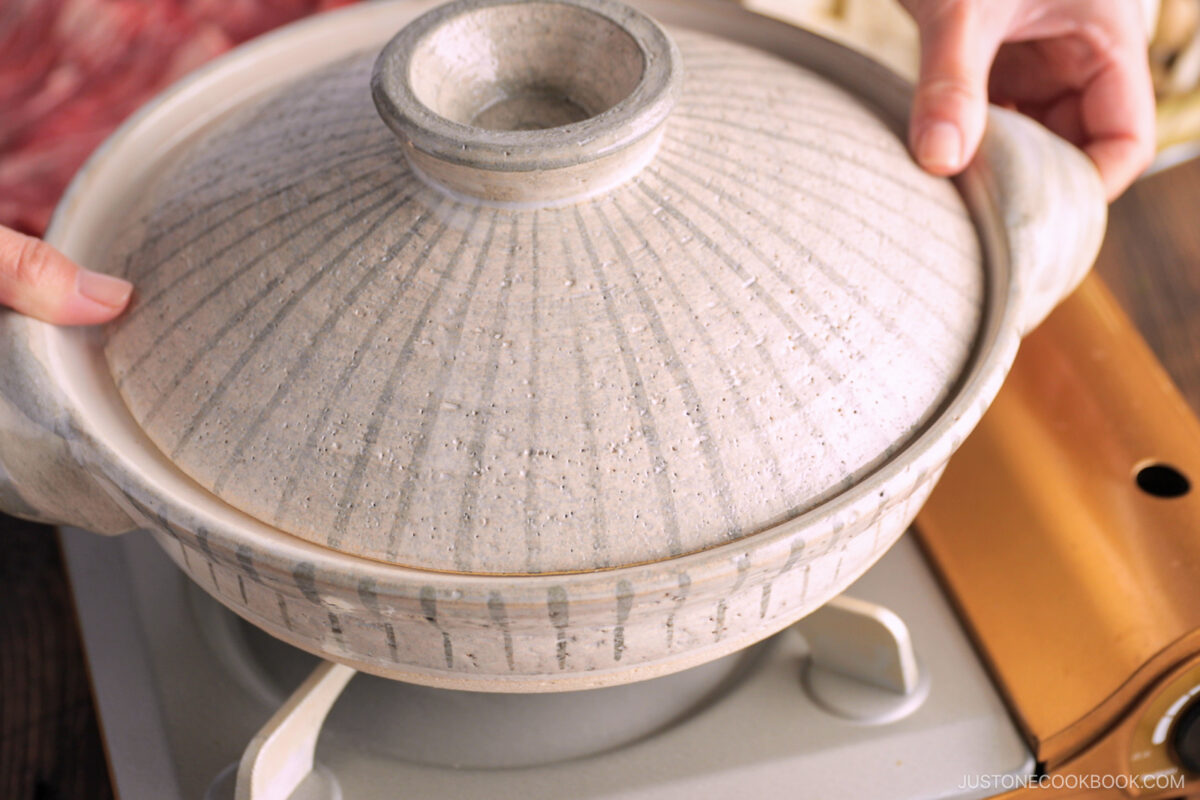
Cooking
Step 5 – Cook the dense vegetables. Bring the dashi to a boil over medium heat; remove the kombu just before boiling. Add the tofu, thick parts of the napa cabbage and shungiku, carrots, and some mushrooms. Simmer until cooked.
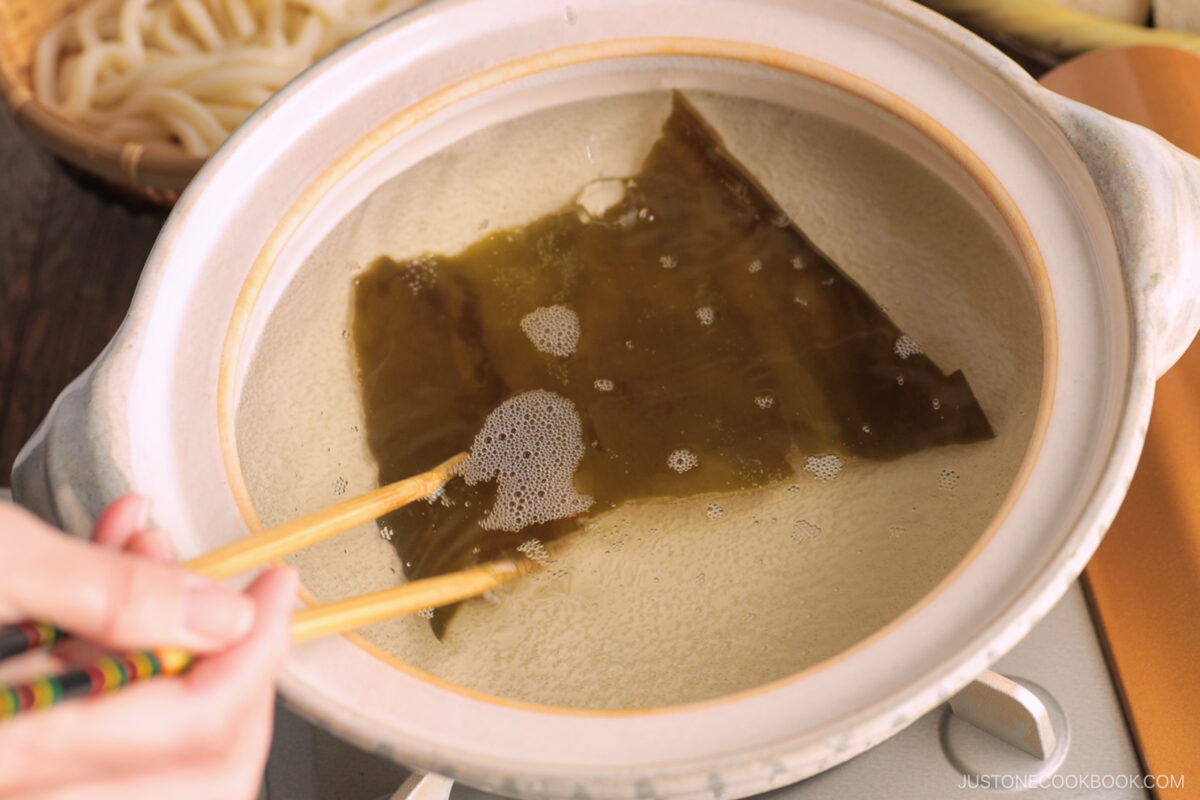
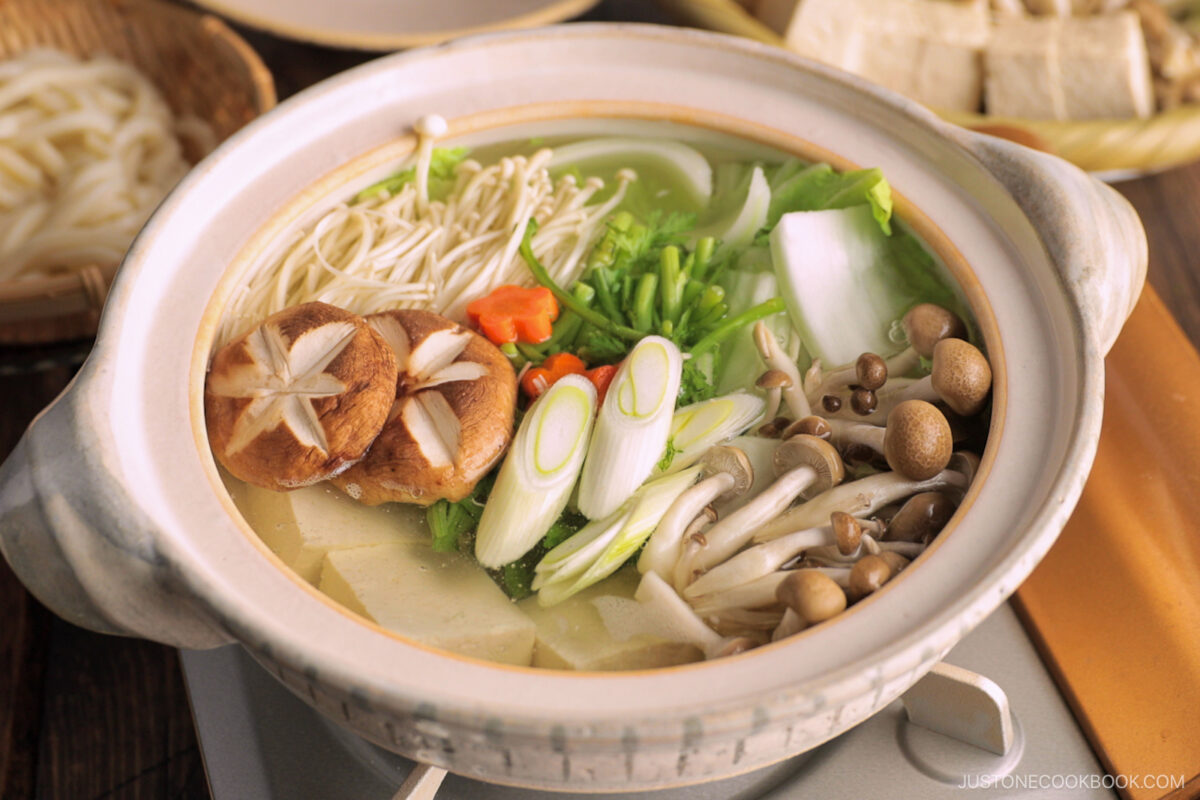
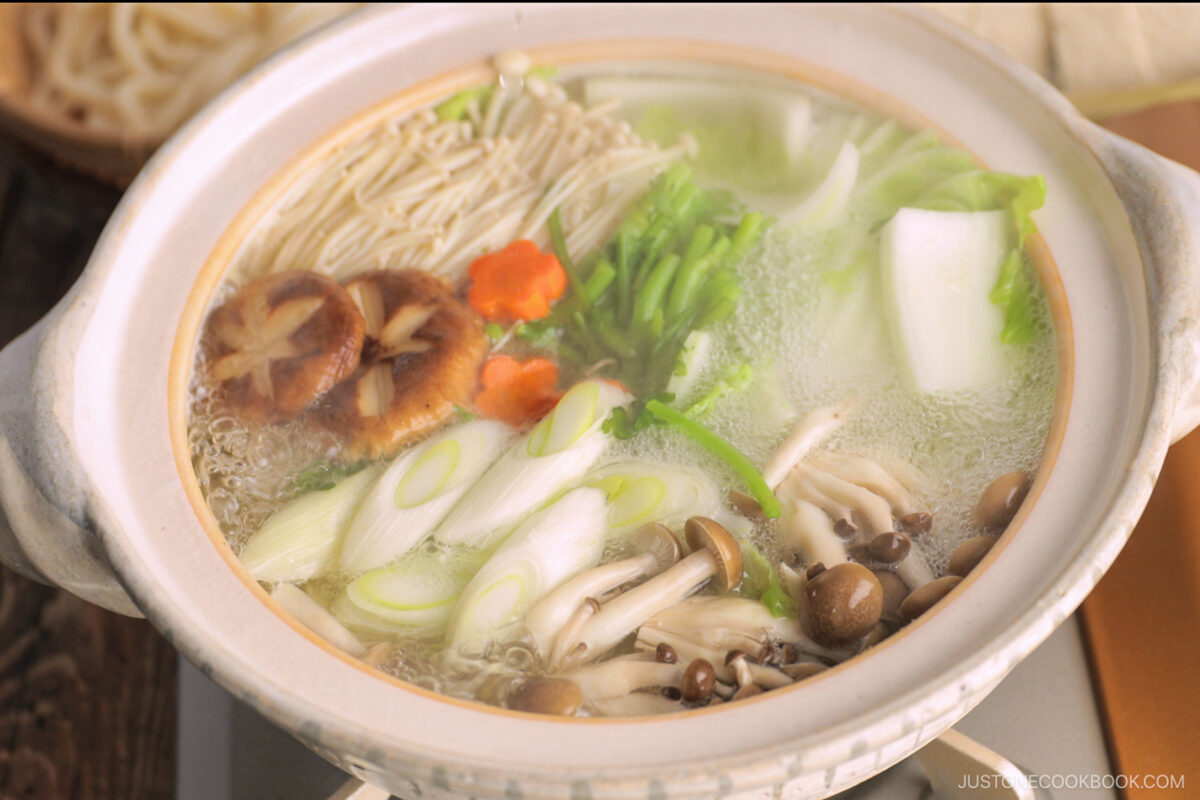
Step 6 – Cook the meat. Briefly swish the beef in the broth until no longer pink.
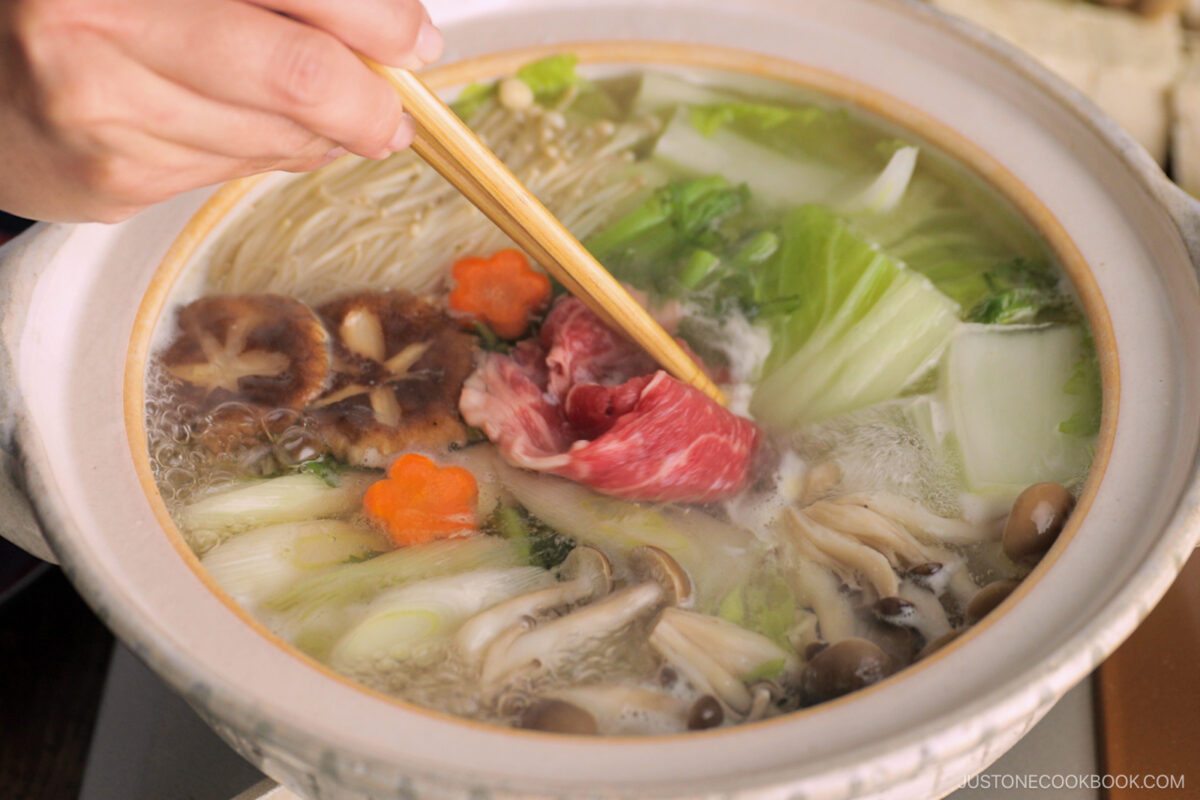
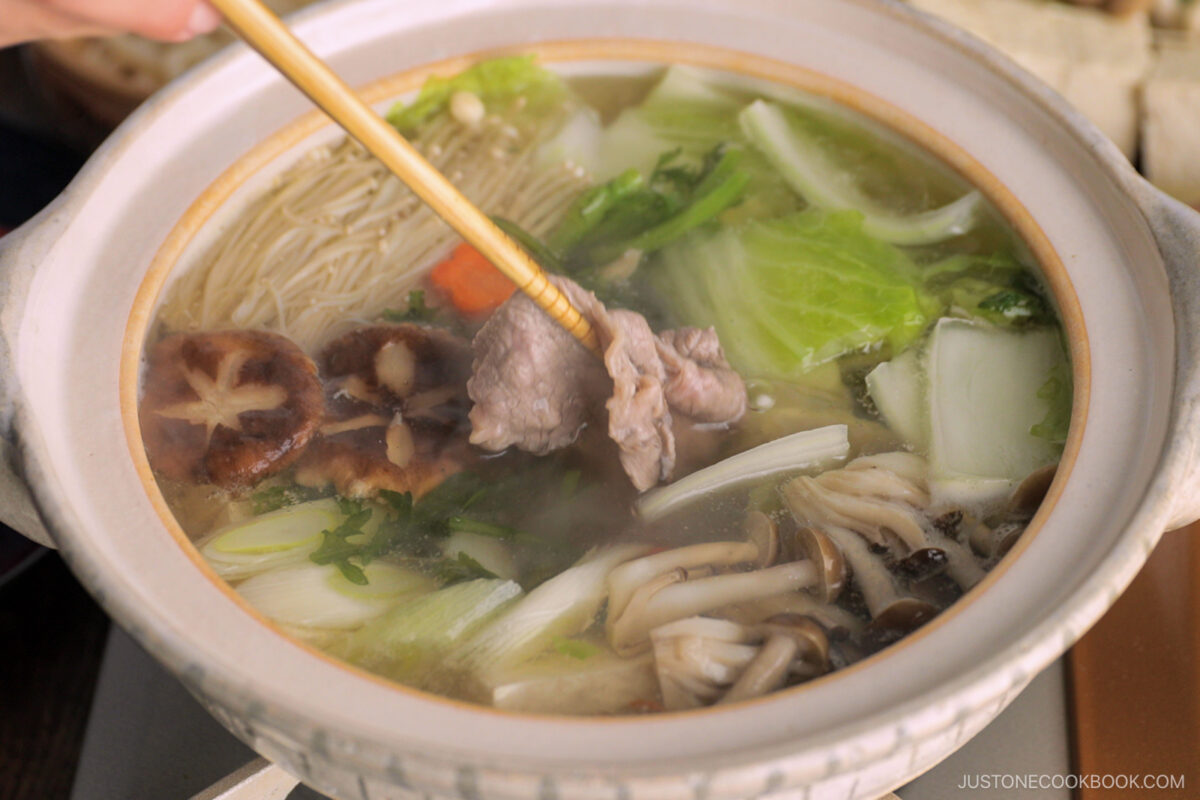
Step 7 – Serve and keep cooking. Self-serve the cooked food as it’s ready and dip in sauces to enjoy.
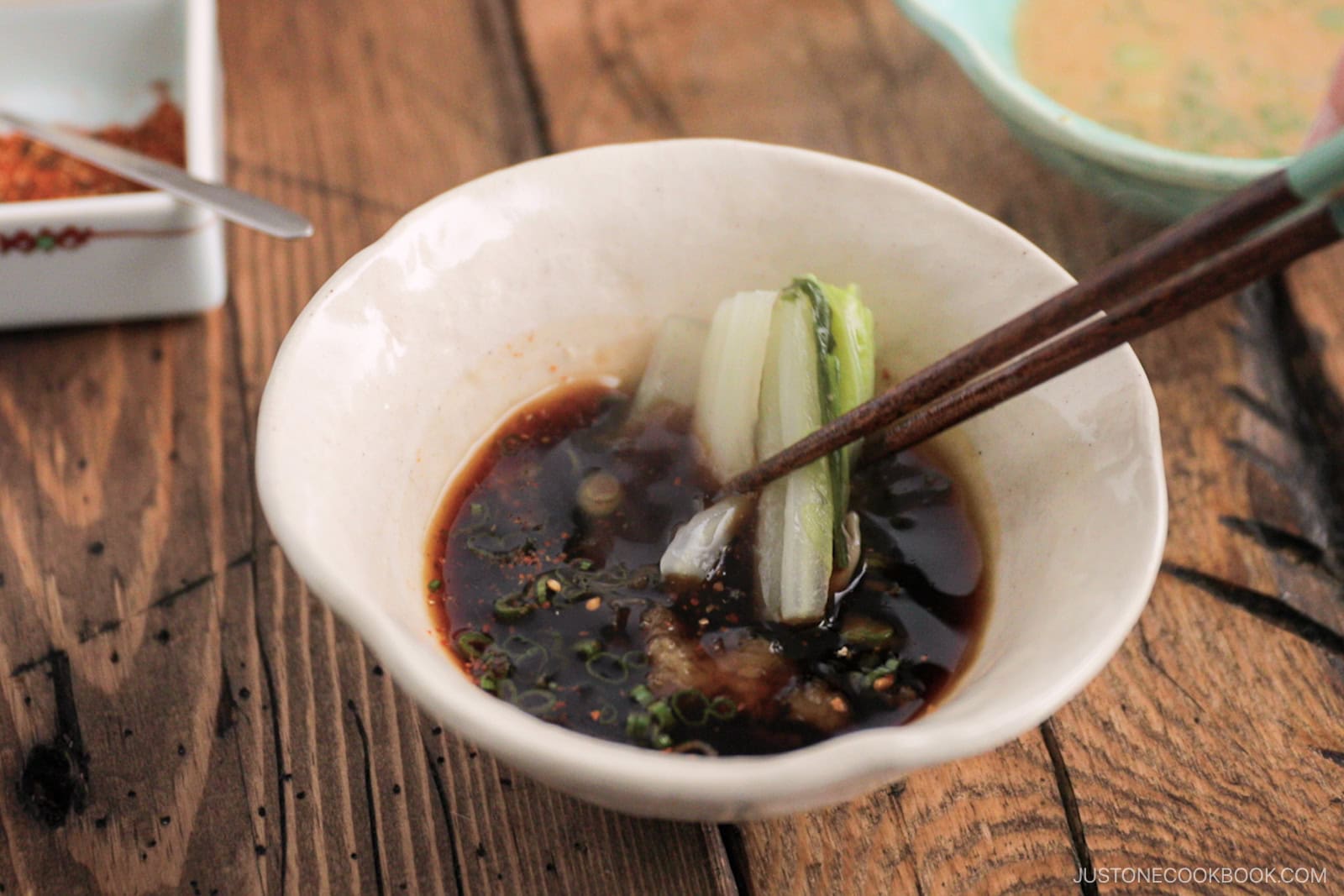
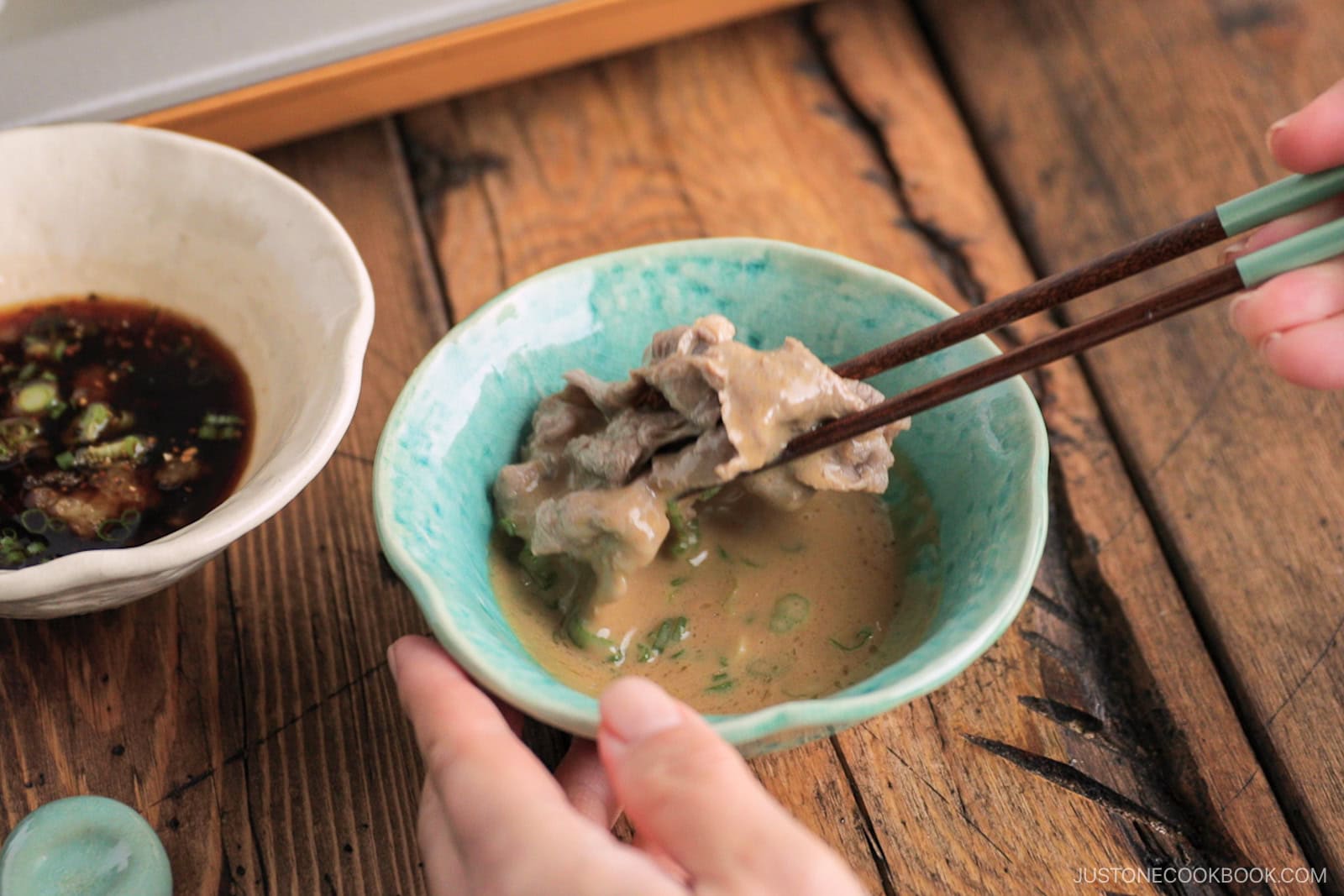
Step 8 – Skim and add the leafy vegetables. Cook until tender and serve. Cook the meat as you’re ready to eat, and enjoy the other ingredients while restocking the pot along the way.
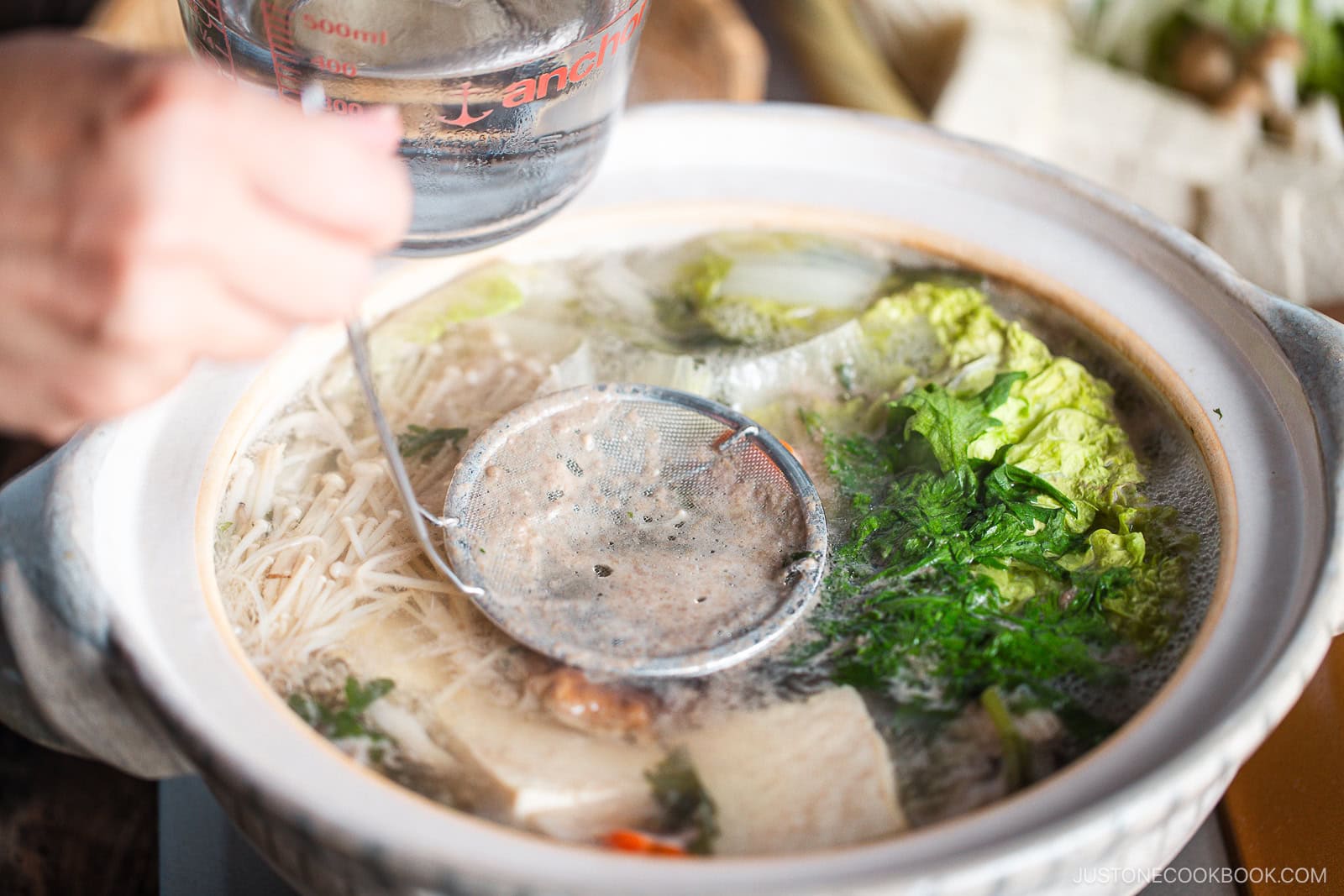
Step 9 – Make the udon finishing course. After the main course of the meal, heat the noodles and serve in the bowls of ponzu sauce diluted with shabu shabu broth.
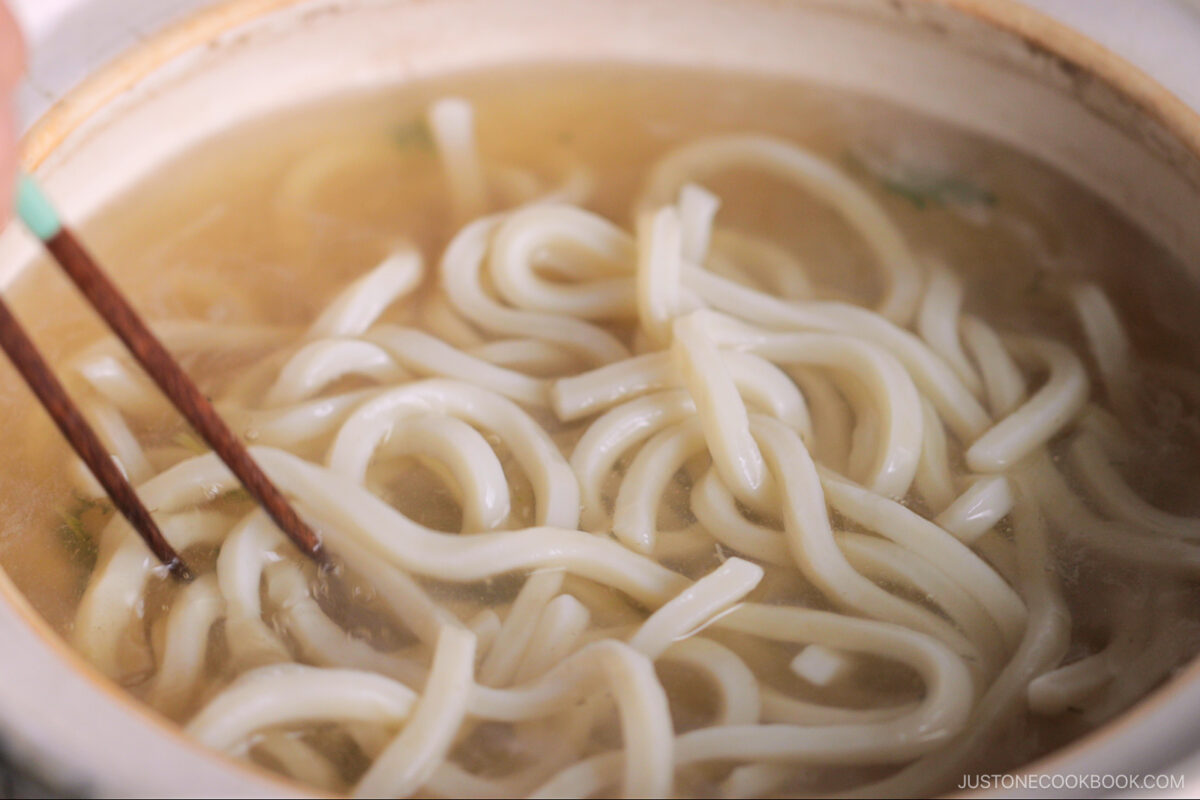
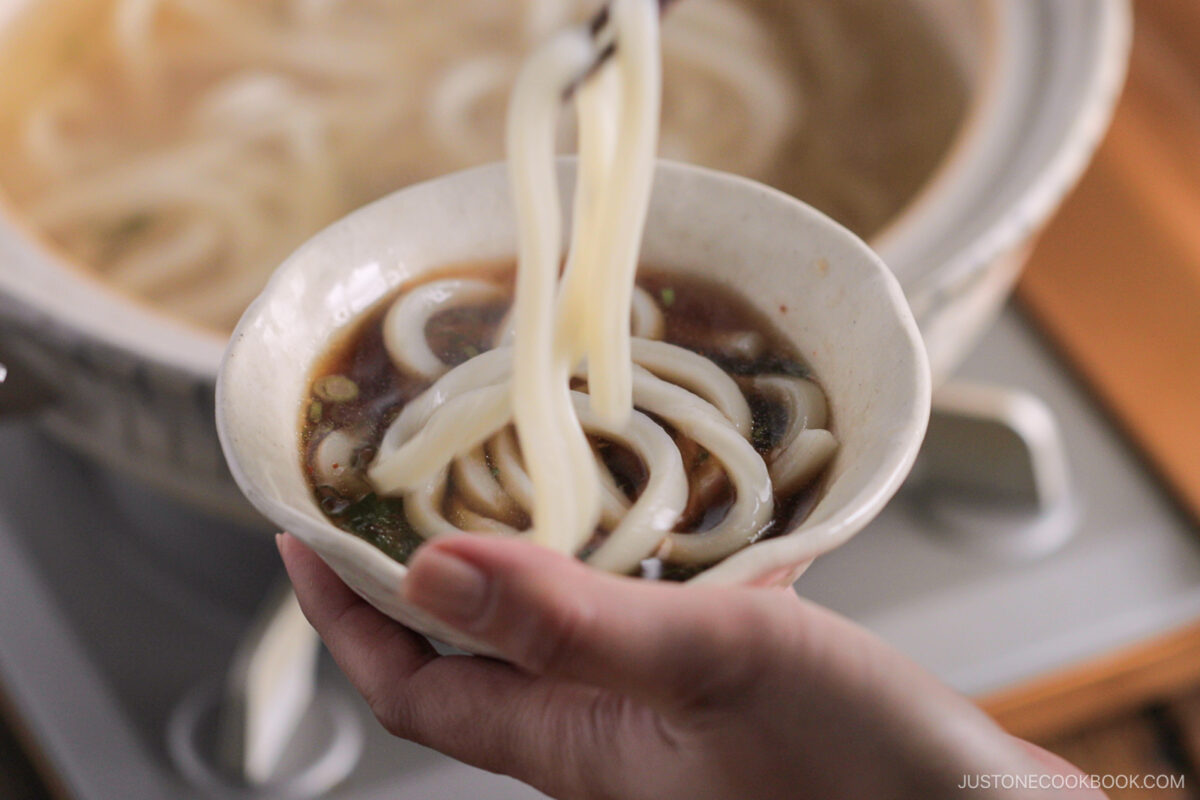
Nami’s Recipe Tips
- Use a pot that retains heat – We use a Japanese earthenware pot called donabe (土鍋) that distributes and retains heat well. You could also use a heavy-bottomed pot or an electric hot pot.
- Use paperthin meat – The well-marbled beef adds flavor to the broth and the thin slices take seconds to cook. Simply swish the slices in the broth with cooking chopsticks and be careful not to overcook it.
- Prep all the ingredients beforehand – Cooking goes quickly, so make sure everything is ready to go before you start.
- Cook the food in order – Start cooking the dense vegetables first until tender, then briefly swish the thin-sliced beef in the hot broth and serve. Add the soft leafy vegetables afterwards and cook until tender.
- Pick one person to cook the meat – This way, everyone gets meat at the same time. They can serve directly to the individual bowls around the table as each piece is done cooking.
- Clean the broth as you cook – Skim off the scum and foam from the surface with a fine-mesh skimmer to keep the broth as clean as possible.
- Cook in batches – If your cooking vessel can’t fit everything, cook a first round with a portion of the ingredients. Then, cook another round as you eat and make more room in the pot.
Variations and Customizations
- Use other proteins. We typically cook hot pot with thinly sliced beef and pork, but occasionally, we cook seafood or chicken as in my Chicken Hot Pot called Mizutaki.
- Add different vegetables. Try cabbage, broccoli, zucchini, carrots, other leafy Asian greens, and sweet corn (cut in sections).
- Use rice for the finishing course. Instead of udon, add cooked Japanese rice to make a porridge with the flavorful broth. Stir in beaten eggs to add extra substance and protein.
- Make it vegan/vegetarian. Simply omit the meat. The dashi, tofu, udon, and dipping sauces are all plant-based shabu shabu ingredients. For greater variety, I suggest adding a mixture of tofu, such as grilled tofu or tofu puffs.
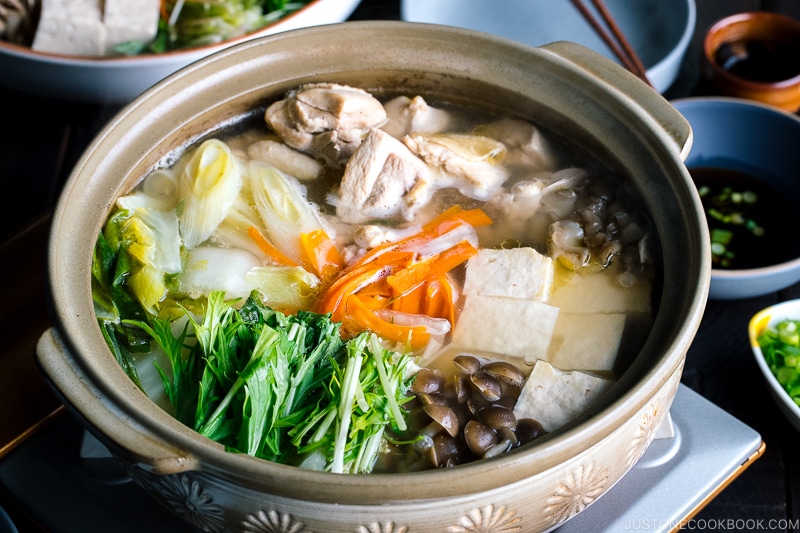
Storage Tips
To store: You can keep the leftovers in an airtight container and store in the refrigerator for 3 days or in the freezer for a month.
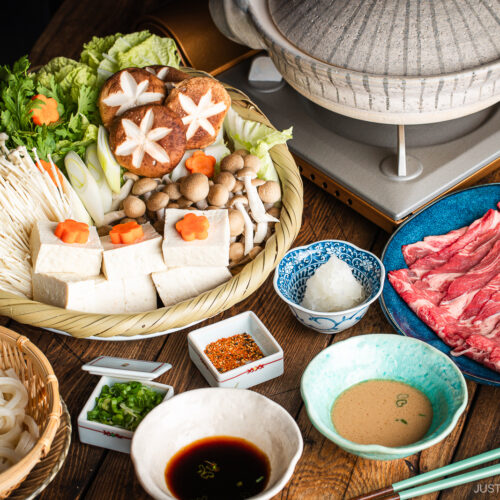
Shabu Shabu
Video
Ingredients
- 1 piece kombu (dried kelp) (1 piece per large donabe; 10 g, 3 x 3 inches, 7.5 x 7.5 cm per piece)
- water
- 1 serving udon noodles (8.8 oz, 250 g frozen or parboiled udon noodles; 3 oz, 90 g dry udon noodles)
- 8 leaves napa cabbage (12 oz, 340 g)
- ½ bunch shungiku (chrysanthemum greens) (4 oz, 113 g)
- 1 Tokyo negi (naga negi; long green onion) (white part only; 4 oz, 113 g; or use 1 leek or 2 green onions)
- 1 package enoki mushrooms (7 oz, 200 g)
- 1 package shimeji mushrooms (3.5 oz, 100 g)
- 4 shiitake mushrooms (2.3 oz, 65 g)
- 2 inches carrot (2.3 oz, 65 g)
- 1 package medium-firm tofu (momen dofu) (14 oz, 396 g)
- 1 lb thinly sliced beef (chuck or ribeye) (4–5 oz, 113–140 g per serving)
For the Sauces and Garnish
- ponzu (store bought or make my Homemade Ponzu Sauce)
- sesame dipping sauce (store bought or make my Homemade Sesame Sauce)
- 2 inches daikon radish (5 oz, 143 g)
- 2 green onions/scallions (0.9 oz, 25 g)
- shichimi togarashi (Japanese seven spice) (optional, for a spicy kick)
Instructions
Before You Start…
- You can make my Homemade Ponzu Sauce and Homemade Sesame Sauce from scratch ahead of time. You can also purchase these sauces at Japanese grocery stores.
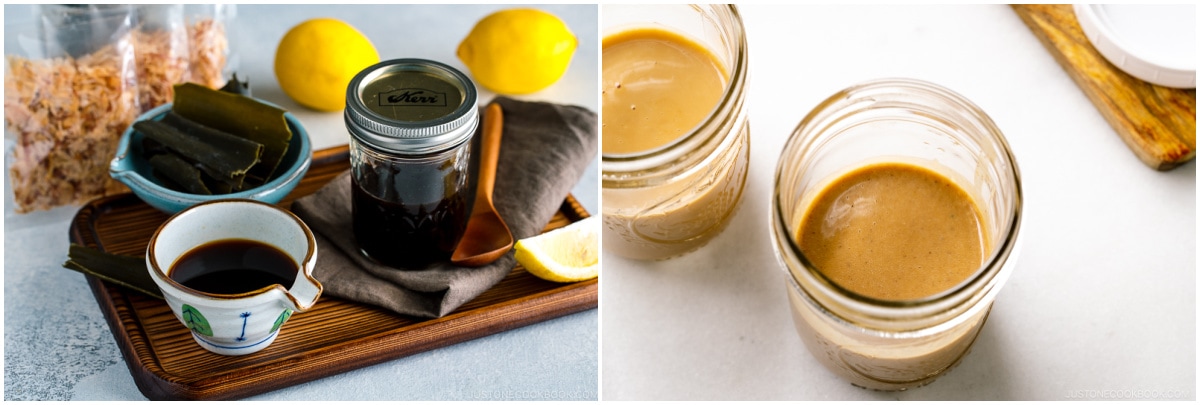
- Gather all the ingredients.
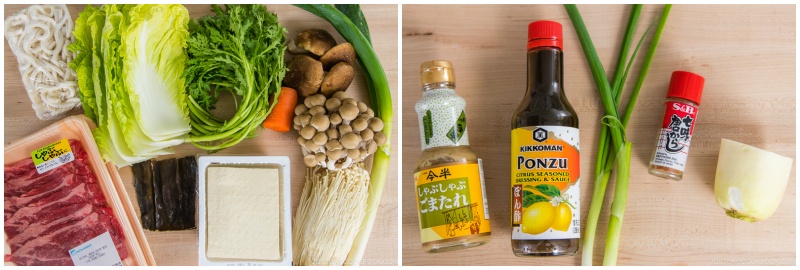
To Prepare the Stock
- Fill 1 large donabe clay pot (or Dutch oven or any heavy-bottomed pot) two-thirds full of water. Add 1 piece kombu (dried kelp) and soak for at least 30 minutes. Meanwhile, prepare the other ingredients. The right image shows the kombu dashi after 30 minutes. Note: Use 1 piece of kombu per large donabe. If you‘re doubling this recipe, use two donabe and put 1 piece of kombu in each pot.
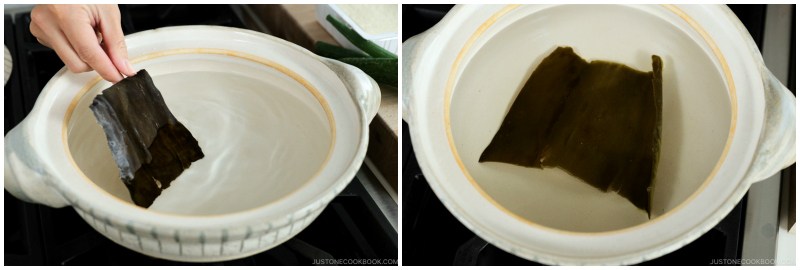
To Prepare the Hot Pot Ingredients
- Prepare the udon noodles according to the package instructions. I use 1 serving udon noodles (still frozen) and reheat it in boiling water for 1 minute. Transfer them to iced water to stop the cooking, then drain well. Place on a plate and set aside. The meal ends with the udon course after you‘ve eaten the main meal.

- Cut 8 leaves napa cabbage crosswise into 2-inch (5-cm) pieces, and then cut each piece in half or thirds lengthwise. Keep the tough/thick parts and leafy pieces in separate piles.
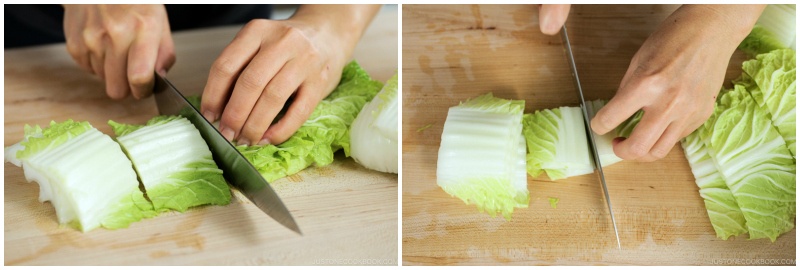
- Cut ½ bunch shungiku (chrysanthemum greens) into 2-inch (5-cm) pieces. Keep the thick parts and leafy pieces in separate piles.
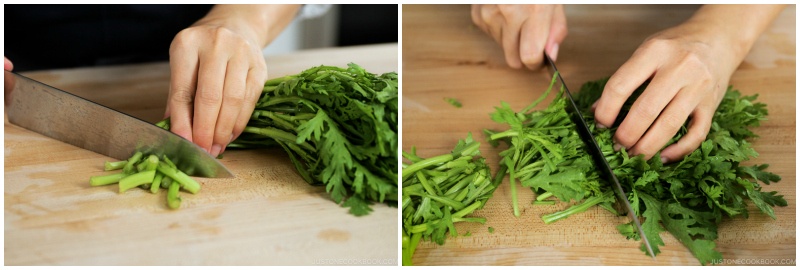
- Diagonally cut only the white part of 1 Tokyo negi (naga negi; long green onion) into pieces ½ inch (1.3 cm) thick. Tip: Reserve the green part for another use, like making Homemade Chashu.
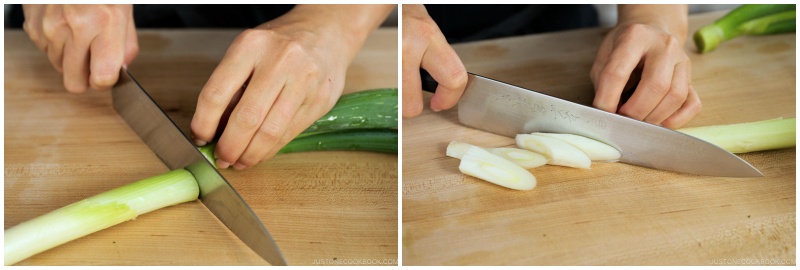
- Rinse 1 package enoki mushrooms and 1 package shimeji mushrooms. Discard the root ends of both mushrooms and separate them into smaller chunks.

- Cut off the stems of 4 shiitake mushrooms. Optionally, cut a decorative flower pattern on the caps (see How to Cut Shiitake Hanagiri).

- Cut 2 inches carrot into ¼-inch rounds. Optionally, you can use a vegetable cutter to cut the carrots into a flower shape.

- Cut 1 package medium-firm tofu (momen dofu) into square pieces about 1 inch (2.5 cm) thick.
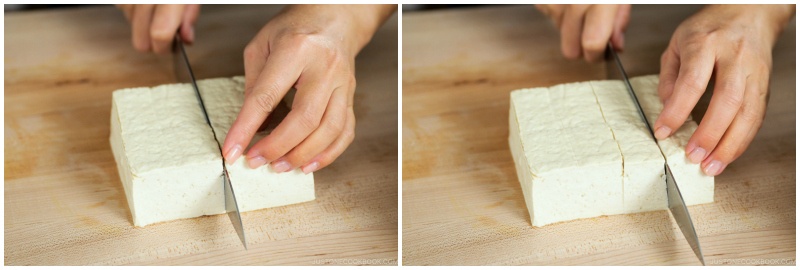
- Arrange all the vegetables, mushrooms, and tofu on a serving platter.
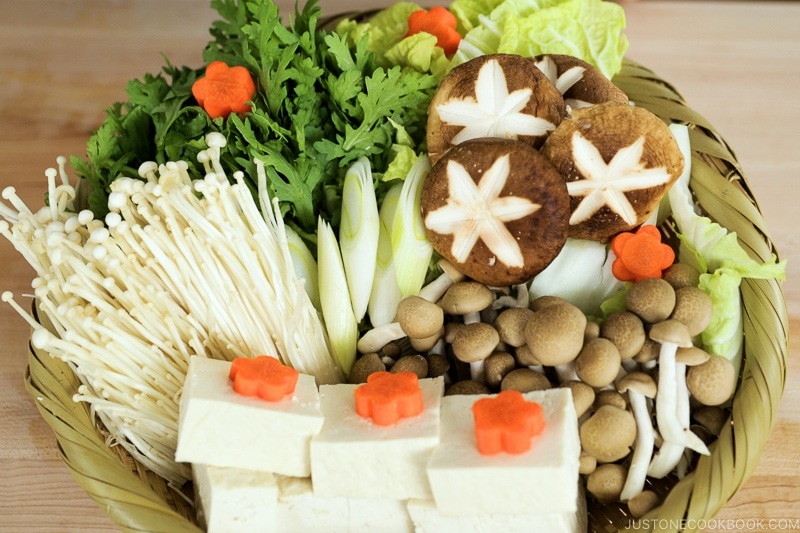
To Prepare the Garnishes and Beef
- Peel 2 inches daikon radish and grate it (I use a ceramic grater). Squeeze it gently to remove most of the liquid and put the grated daikon in a small bowl.
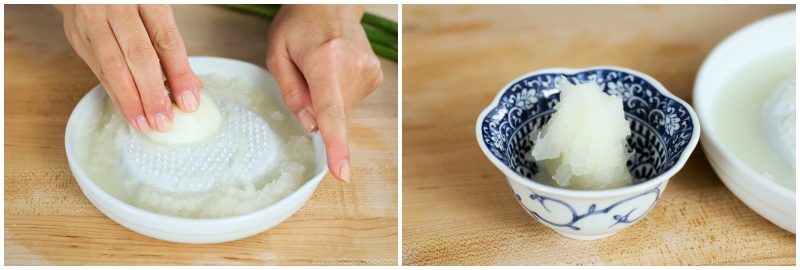
- Cut 2 green onions/scallions into thin rounds and put it in a bowl.
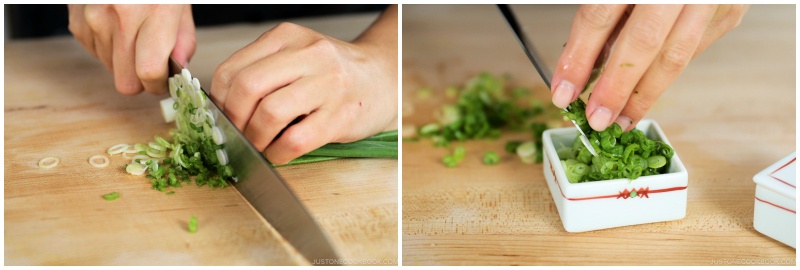
- Prepare optional shichimi togarashi (Japanese seven spice) in a bowl. Lay the 1 lb thinly sliced beef (chuck or ribeye) on a platter.
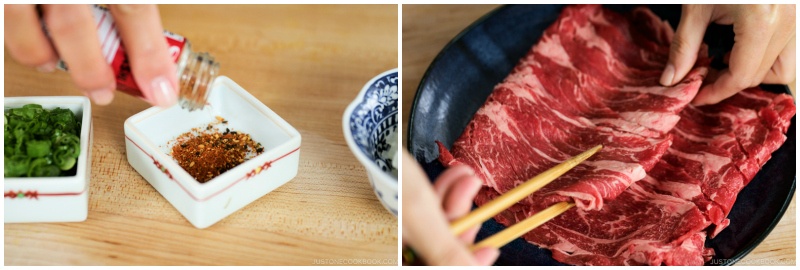
To Cook the Shabu Shabu
- Set up a portable gas stove at the table and put the donabe on the burner. Place the platters with the ingredients on the table. Give each person their own bowls of ponzu and sesame dipping sauce. I also prepare a shallow bowl for each diner to cool their food.
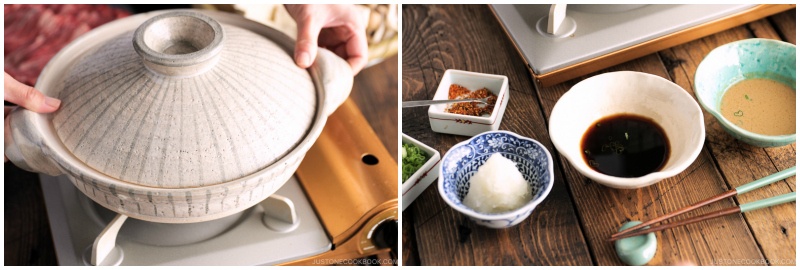
- Bring the broth to a simmer over medium heat. Take out the kombu right before water starts to boil (otherwise, the water will get slimy).
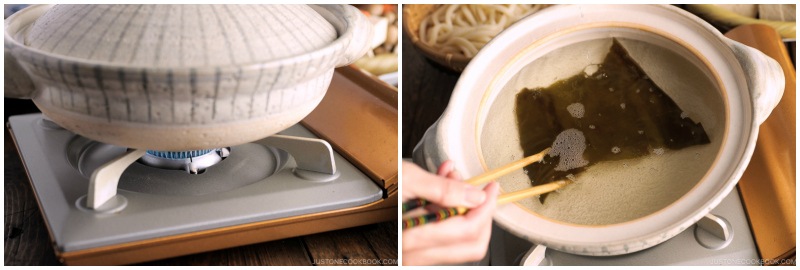
- Add the tofu, tough parts of napa cabbage and shungiku, negi, carrots, and some mushrooms. Reserve the softer, leafy vegetables to cook later. You don’t have to put all the ingredients in at once; cook in batches, if you prefer. Cover to cook for 10 minutes.
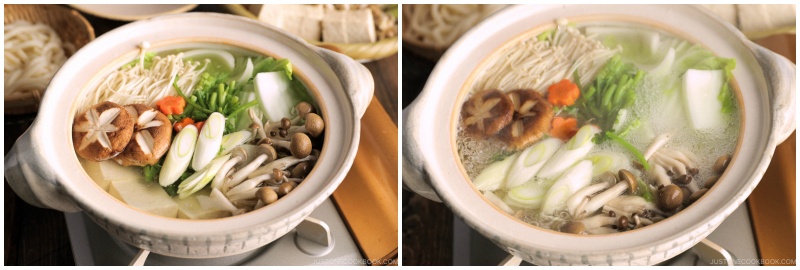
To Eat the Shabu Shabu
- While you’re waiting for the food to cook, prepare your dipping sauces. Add the grated daikon, shichimi togarashi, and green onion to the ponzu. Add the green onion to the sesame sauce.

- When you‘re ready to eat the meat, pick up a piece of thinly sliced beef with a set of communal cooking chopsticks. Stir or “swish“ the meat in the boiling broth and cook for 20–30 seconds or until the meat is no longer pink; be careful not to overcook it.
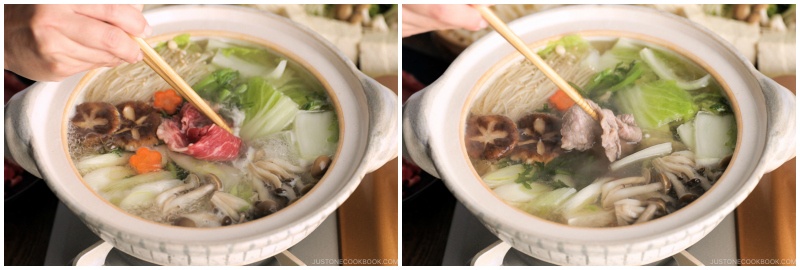
- Serve the beef, vegetables, mushrooms, and tofu once cooked and enjoy the food dipped in ponzu or sesame sauce.
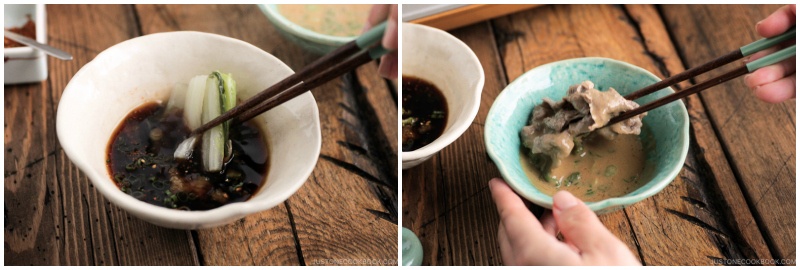
- Skim off the scum and foam from the surface, especially after cooking the meat, to keep the broth as clean as possible. Then, add the softer, leafy vegetables to the broth as you make room in the pot. Simmer for a few minutes and serve. Cook the meat as you're ready to eat, and enjoy the other ingredients while restocking the pot along the way.Tip: Prepare a fine-mesh skimmer and a 2-cup measuring cup filled with water so you can easily skim as you cook at the table. The water will help clean the skimmer.
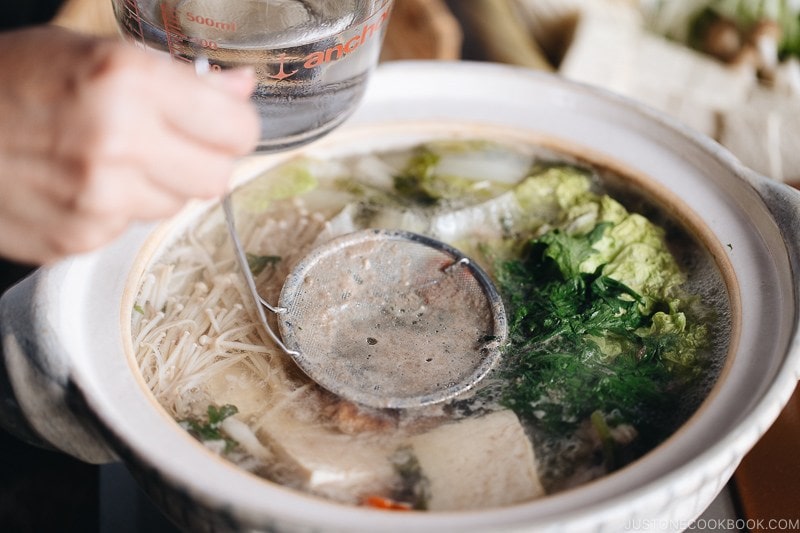
To Make the Udon Course
- When you're done cooking the ingredients, skim the broth one last time to prepare for the udon noodles. Typically, a hot pot meal ends with cooking udon noodles or porridge.
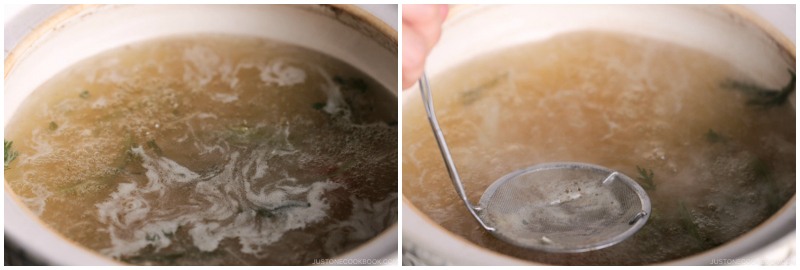
- Add the udon noodles to the pot and reheat for 1–2 minutes. Lightly season the broth with salt and white pepper, if you‘d like (optional).
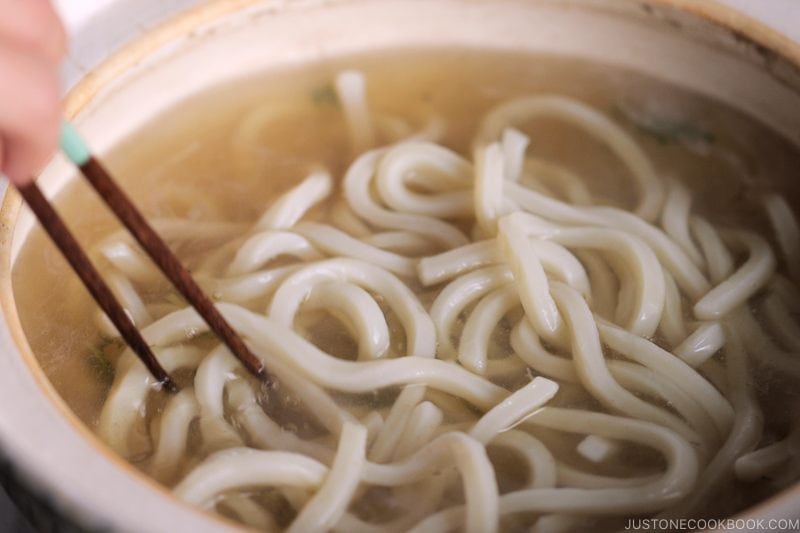
- Dilute the individual bowls of ponzu sauce with the broth and serve the udon noodles in each bowl.
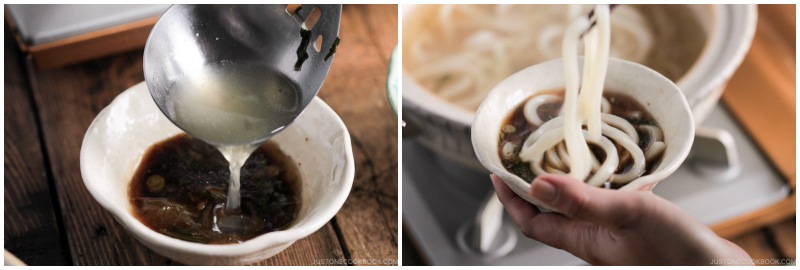
To Store
- You can keep the leftovers in an airtight container and store in the refrigerator for 3 days or in the freezer for a month.
Nutrition
Editor’s Note: This post was originally published on December 2, 2011. It was updated with a new video and new images in December 2018. It was republished with more helpful content on April 11, 2025.
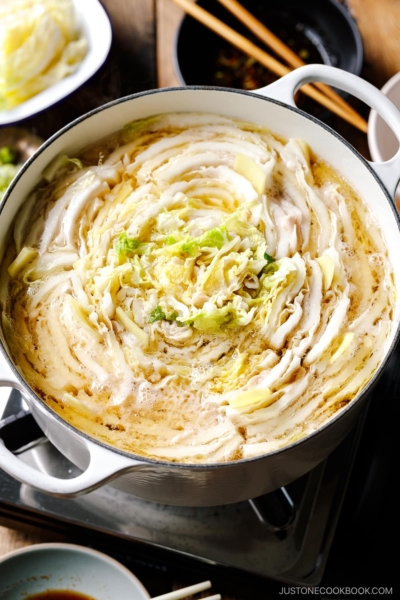
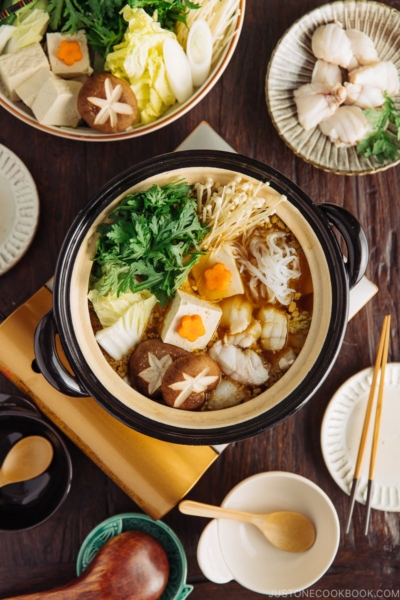
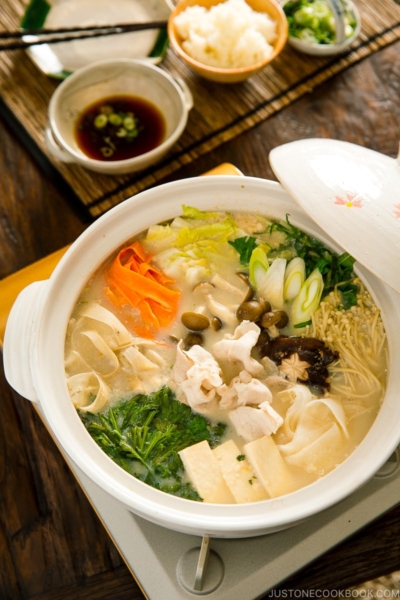
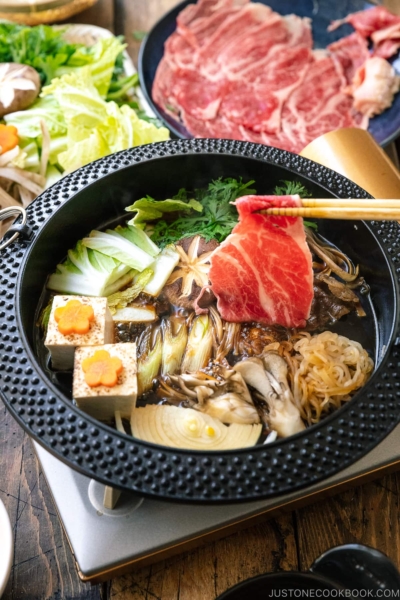





beautifully done. I will give it a try thus weekend.
Hope you enjoy this recipe, Michelle!
Hi Nami, and happy belated holidays…hope you were able to enjoy with family. I’m a long time reader of your blog, as well as your book. You have a wonderful way of explaining how to make amazing dishes. I’ve recently become fascinated with hot pot recipes, and just purchased a donabe, burner, gas, vegetable cutter, etc. For my first try, would you recommend cooking Shabu Shabu or Sukiyaki? Thank you in advance.
Hi John! I apologize for my late response. Happy New Year! Thank you for reading my blog for a long time. I’m really happy to hear you enjoy my recipes. 🙂
I think shabu shabu is easier to make, but both are equally delicious. Hope you enjoy making hot pot recipes at your dining room. It’s fun, easy, and delicious meal in winter time!
Love the name of this dish — so much fun to say. You did a great job with the recipe — thanks.
Thank you so much for your kind words, John! 🙂
Extremely thorough and easy to follow directions. The photos make the process so clear and I like the upbeat music, too.
Hi Paul! Thank you so much for your kind words. I’m glad to hear you think the video and step by step recipes are helpful. Thanks!!
Can u name what kind of meat I need to use for shabu shabu??? If it is a beef what type of beef or part of the beef meat?
Hi Joy! Shabu shabu is typically beef or pork. For beef, I recommend ribeye or chuck. For pork, I recommend pork tender loin. Freeze a little bit and slice thinly with sharp knife. 🙂
https://www.justonecookbook.com/how_to/how-to-slice-meat/
Hi Nami
I noticed you did not add seasoning to the shabu shabu stock. Do the Japanese drink the soup? Unlike other Asian countries, the hotpot/steamboat stock is usually made by boiling chicken bones or pork ribs.
Also, I would like to know the purpose of using kombu in the stock? Thanks
Hi Grace! We don’t add any “seasonings” to shabu shabu. Shabu shabu stock is always kombu dashi (mdade with kombu and water) and that’s it. We don’t “drink” the soup (you could) but we usually eat udon or porridge using the leftover stock (after everyone eat the ingredients in the pot). Yeah, other Asian hot pot use heavy stock, but Japanese focus on fresh ingredients and umami from kombu. It’s much simpler taste, so it’s important to use fresh ingredients.
The purpose of kombu – it’s the Japanese dashi. Maybe you can check this post about Japanese dashi (broth). 🙂
https://www.justonecookbook.com/how_to/how-to-make-dashi-jiru/
I dont care much for mushrooms, any other veggie suggestions? Do you think using peppers/squash would be a bad idea?
Hi Jesse! Sure you can, although they are not “typical” ingredients for Shabu Shabu. Honestly, you can put any veggies of your choice (even cabbage of broccoli for example, which are not typical). Hope you enjoy this recipe!
Hello! I was interested in making this recipe, but have no clay pot to make it in. Could you recommend me a Japanese one I could order online? Also, after moving it to the table will it continue to stay hot enough?
Thank you!
Hi Emma! You don’t have to use clay pot and use a regular pot or dutch oven. Clay pot or dutch oven keep the food warm for a long time. Amazon or Japanese/Asian grocery stores sell “Donabe” too.
http://amzn.to/1kE23Ib
http://amzn.to/1Z0TWs1
and many more.
And at the table, you should have a portable cooking stove.
http://amzn.to/1Z0U4HT
You will need a gas canister for it.
http://amzn.to/1Z0Ucr0
Hope this helps!
I was wondering if I would be able to cook the Shabu Shabu on a gas stove or like would I need something else?
Hi Victoria! You can cook on the gas stove first and serve too, but it’s more fun to cook at the table (it’s a fun part of hot pot). You can get a portable gas stove like this (http://amzn.to/1E07V4B). That way, you can cook meat when you want to eat, and it doesn’t get hard. Same for vegetables. There’s something about cooking right in front of you and pick up and eat right away. Vegetables won’t be wilted as much. Hope I answered to your question…? 🙂
I just found a wonderful website. Please continue with all your wonderful recipes, stories and explanations. I have learned so much. Will Definitely revisit.
Hi Marcella! I’m so happy to hear you like my website, and thank you for your kind words! I hope you come back soon or subscribe to my newsletter. 🙂
I love this meal so much! After my family eats the udon, we add raw eggs and rice and cook it in the remaining broth. This is my favorite part, mainly because I like eggs. ^^ I must eat shabu shabu now… Thanks for sharing this recipe!
Hi Maya! Welcome to my blog, and I’m happy to hear you enjoy reading my recipes. Hope you enjoy cooking too! 🙂
txs Nami for shabu2 recipe
You’re very welcome! 🙂
So as you suggested, we had shabu shabu last night. It was awesome, you would think sukiyaki is tastier, but the broth becomes tasty and i had shabu shabu at the restaurant and already liked the two different sauces. I tried your ponzu, but i like the recipe i use better (i infuse a piece of kombu and a little bit of katsuobushi in 120mL of shoyu overnight, then filter it and add 4tbsp mirin, 4tbsp of lemon juice and 4tbsp of mandarine juice. You can use whatever, 4tbsp sour citrus juice, 4tbsp sweet citrus, i like to mix them and do with what i have : yuzu juice, blood orange, limes…). On the other hand, just reading the ingredients of your sesame sauce and i knew this would be the best one i ever had, and i was right. I like the heat of the raw sake and mirin, and even though the alcohol level is low, im not supposed to take alcohol so i stress. Is there any extra step i could take, like evaporate the alcool of sake and mirin before mixing them to the other ingredients or something…? Thank you so much again, ill be making hot pots all winter if you have other ideas !
Thank you Sunny for your feedback! I’d try your ponzu recipe next time! Thank you!! xo
Hello. Good evening India time. Every item presented in the most elegant manner. I respect your Quality Care for the foods. Loved it. I would replace Beef slice or Pork with properly baked Potato Slice; if to make it Vegetarian..!!! Would it work? Me sure it should. Potato slice baked and pasted with little salt and black pepper..
Hi Dr. Sharma! I don’t think baked potao slices would work here as they get soggy in a boiling stock, but you can substitute with chicken or other kinds of meat/seafood or simply use vegetables. Hope that helps. 🙂
Love the recipe! Getting a hot pot on sale for the upcoming cold weather for healthier cooking. Thanks for sharing!
Hi Dani! Thank you so much for your comment. Shabu shabu uses lots of veggies and it’s such a light and healthy balanced meal. Not to mention it’s easy to prepare… 🙂 Enjoy!